Back in 1938 Aleister Crowley…
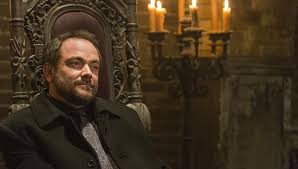
… no not that one..
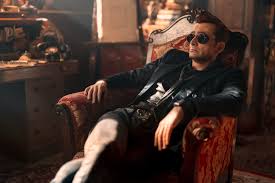
… no, not the one that inspired that one, either…
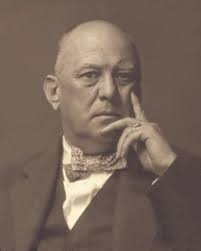
…This guy started working on a tarot deck based on the ‘original’ meanings. He studied under the masters and began a 3-month project to update the tarot and make it relevant to the current Aeon. Like all projects, the resulting cards and accompanying book overran somewhat, by about 5 years. I’m going to talk you through the key points of the book and the history of the revised deck and give you some pointers on the cards themselves. Heads up – there’s a lot of content in here that I believe has been co-opted by conspiracy theorists, numerology, shadowy groups shepherding mankind, magik, (with a K to differentiate it from illusionists’ tricks which are magic with a c), lots of ancient religious references so if you’re sensitive about that kind of thing, give this one a miss.
Is it basically the same?
As with the more widely recognized Rider Waite deck, there are 4 court cards included in the 56-card ‘minor’ deck and 22 in the major, however, Crowley refers to them as the trump cards. Crowley believed the arrangement of these 22 cards to be necessitated by the structure of the universe and the solar system as symbolized in the qabalah. Key to this was the gematria – a science in which the numerical values of a Hebrew word link that word to others of the same value. While he could find no logical or rational explanation for how this could occur naturally in a language, he believed it to be irrefutable.
Eliphas Levi and the Order of the Golden Dawn
Crowley believed that Alphonse Louis Constant, better known as Eliphas Levi Zahed or just Eliphas Levi, understood that the tarot is based on the qabalistic tree of life and that he had been entrusted with this knowledge by the Order of Initiates. Levi’s oath to them meant that his published works on the tarot were deliberately obscured, even outright wrong in some cases. However, thanks to a fortuitous find by a Dr Westcott, Woodford or Woodman, a cypher was found that contained an attribution of the tarot to the letters of the Hebrew alphabet. Further, Crowley believed it was entirely plausible that this cypher was handwritten by Eliphas Levi himself.
Off the back of this finding, Dr Westcott founded the Order of the Golden Dawn, some of the members of the order included Smith, Rider and Waite – yep, the ones who created the more widely known tarot deck. Within a short period, a chap called Frater Perdurado found himself as the de facto head of the order after apparently contacting the ‘secret chiefs’ and becoming their messenger. The secret chiefs are a shadowy council of beings who oversee, amongst other things, the representation and depiction of the tarot and are perhaps charged with keeping humanity on the right path. Between his studies and correspondence with the secret chiefs, Perdurado discovered that the cards of the tarot align with the signs of the zodiac, the planets, the letters of the Hebrew alphabet and the elements. The major arcana, while numbered 0 to 22, must be rearranged in order to tell the true story.
Formation of the Tetragrammaton
Zero – Ain
As I’ve already said, Crowley believed the tarot to be a pictorial representation of the universe as described in the Holy Qabalah. He believed zero in this context stood for any quantity one may choose much as n is used in algebra. He considered the meaning of zero being an absence of anything to be vulgar. In qabala, this is called ain.
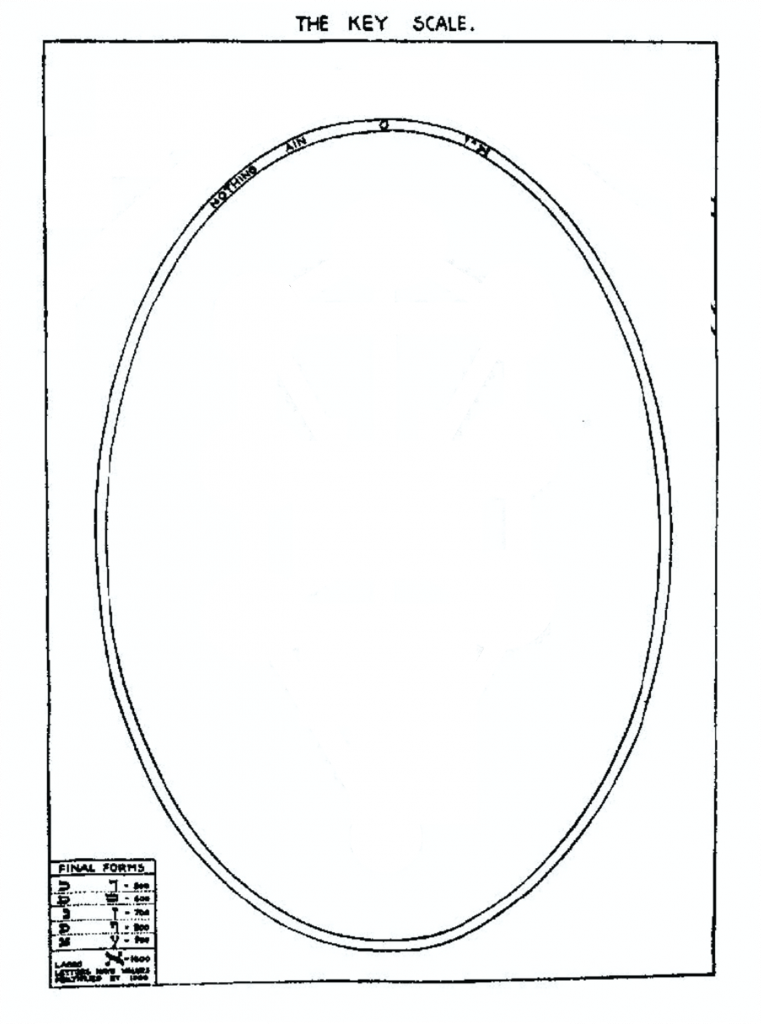
The Naples Arrangement
Okay, this isn’t the easiest concept to explain so bear with me and I’ll do my best.
Zero zero – Ain Soph
Crowley states that the Qabalists took the idea of zero, any quantity, and expanded it to a second nothing, zero zero, which they called ain soph – which means without limit.
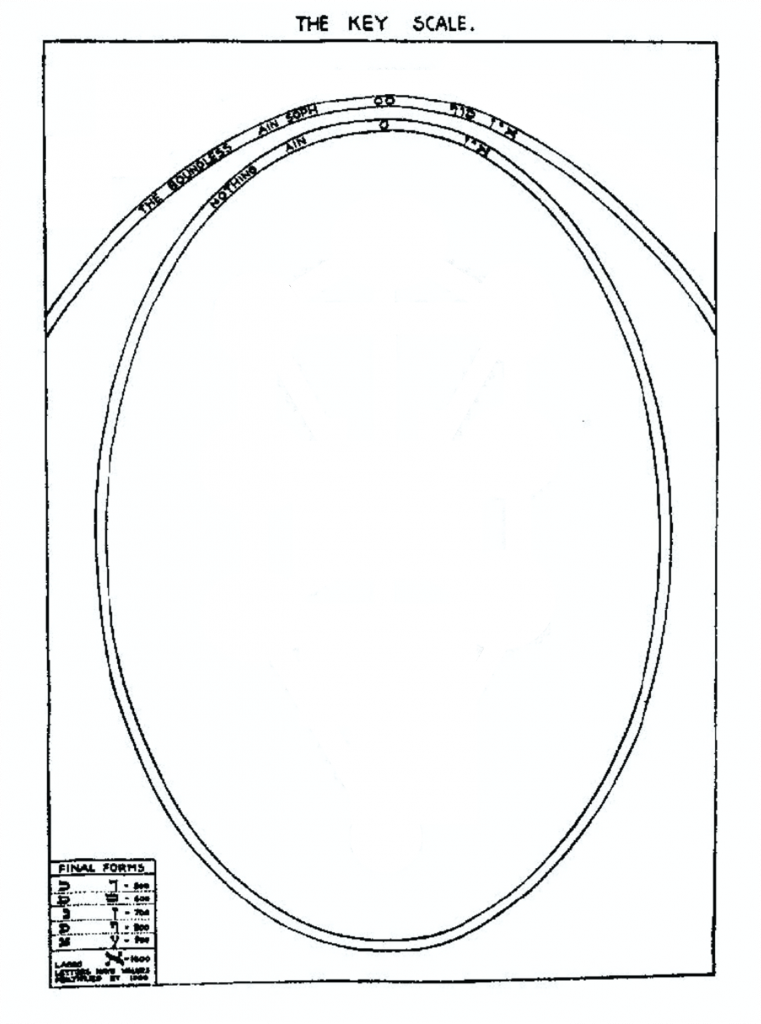
Zero zero zero – Ain Soph Aur
Crowley likens this to the vastness of space. They then interpret this concept of nothing/anything to become ain soph aur or limitless light which Crowley likens to ‘luminiferous ether’ or perhaps the space/time continuum.
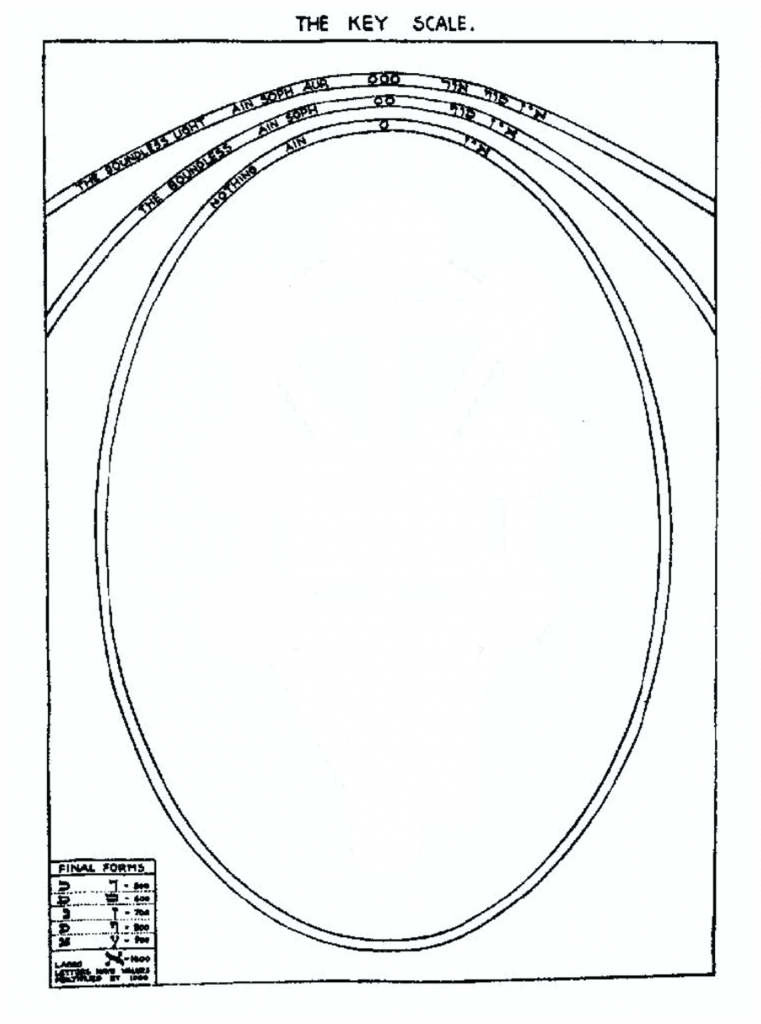
So, we have ain, or zero to represent anything or any quantity, ain soth or zero zero to represent something without limit or space, and ain soth aur – limitless light or the space/time continuum and everything that exists does so within these bounds. With me so far?
One
Now we have our limitless canvas, the next step must be to define a position, that position is numbered one.
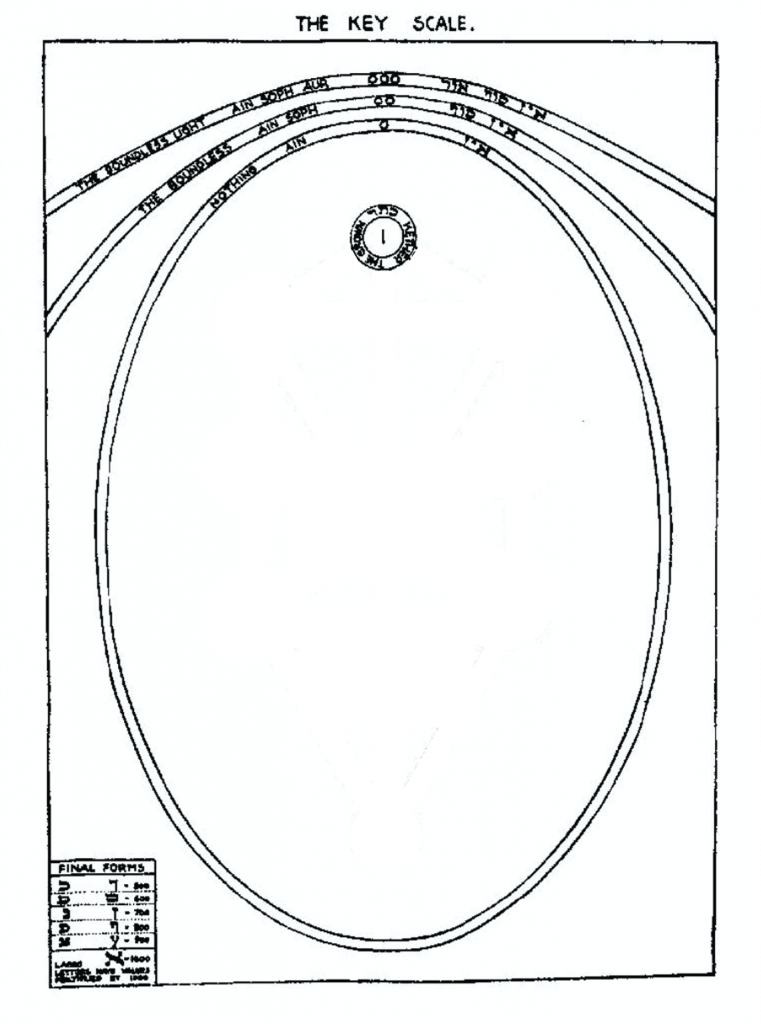
Two
Knowing something has a position isn’t very useful unless we have something to compare it to so we have to create a line to our second point, two.
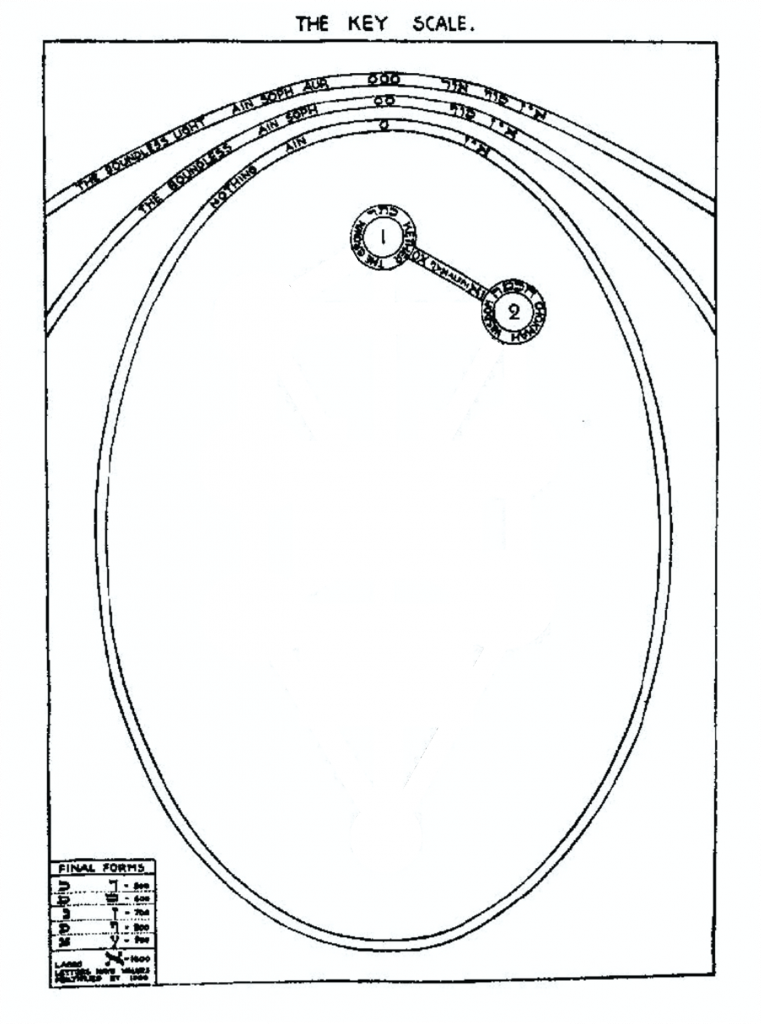
Three
We have a line between two points, but we cannot yet know how long that line is, only that it exists therefore we need another reference point, three, or the surface which now allows us to form a triangle and define the relative distances between the three points.
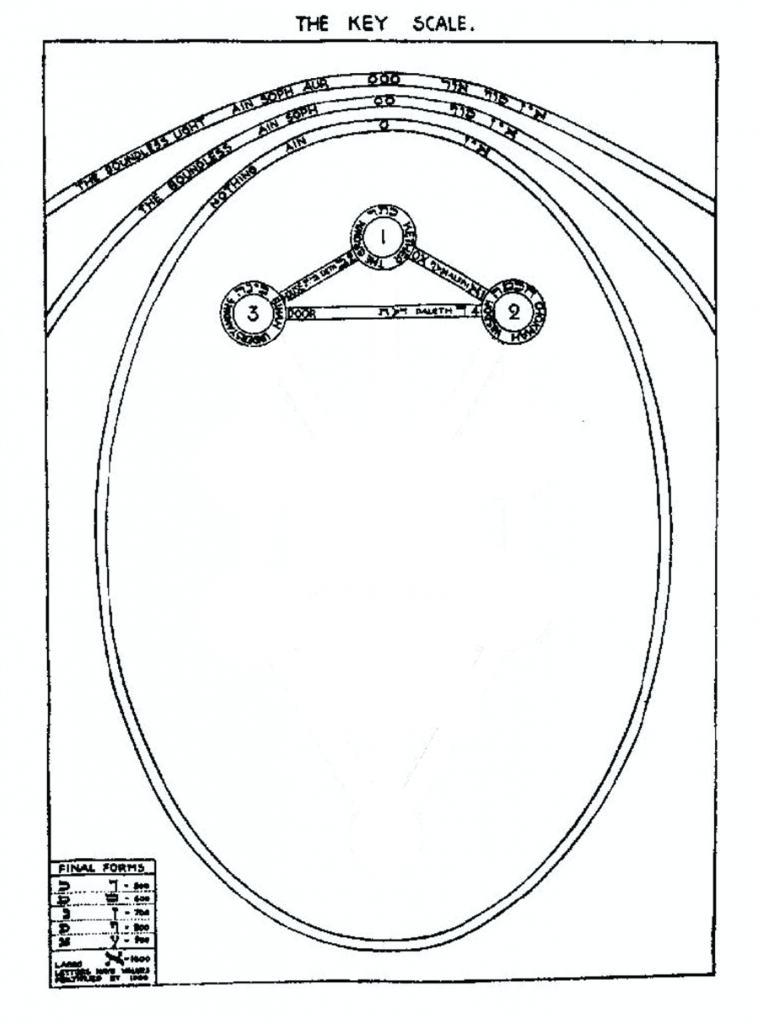
Four
Having that defined that this thing exists in the limitless canvas at a point in the space-time continuum, and we have a rough idea of where it exists, we need to add a third dimension to make it a solid, this reference becomes number 4.
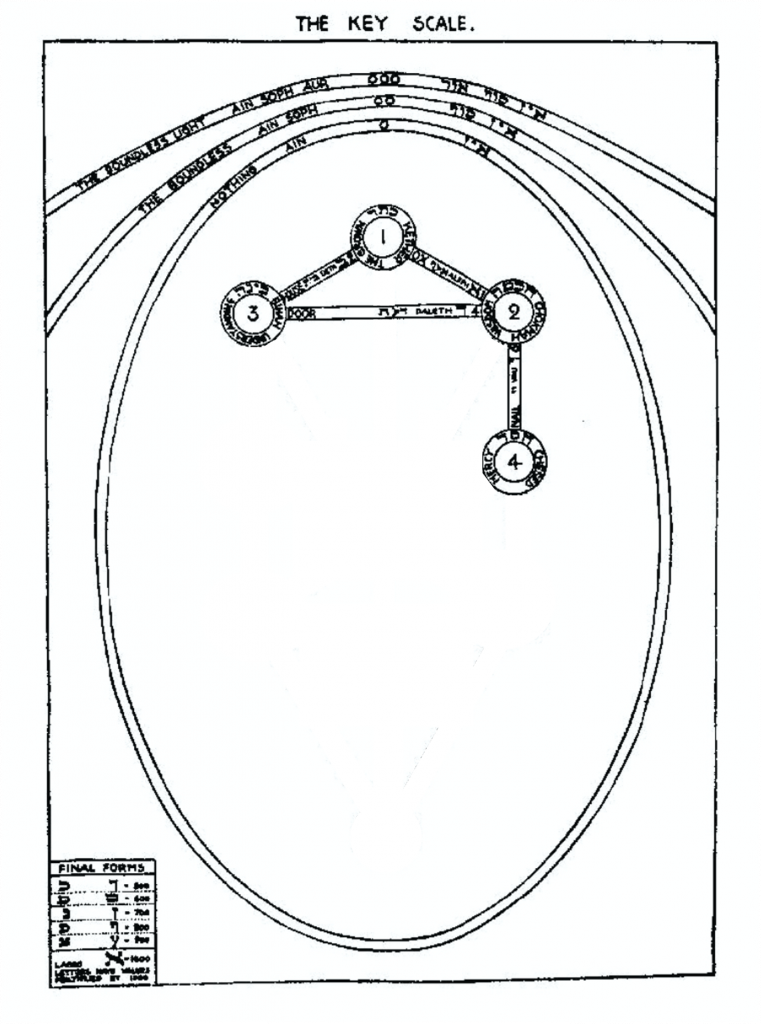
Five
So, if it exists and we know its position in relation to 3 other points we must now consider motion, where has it been, where will it go, this concept is termed motion and numbered 5.
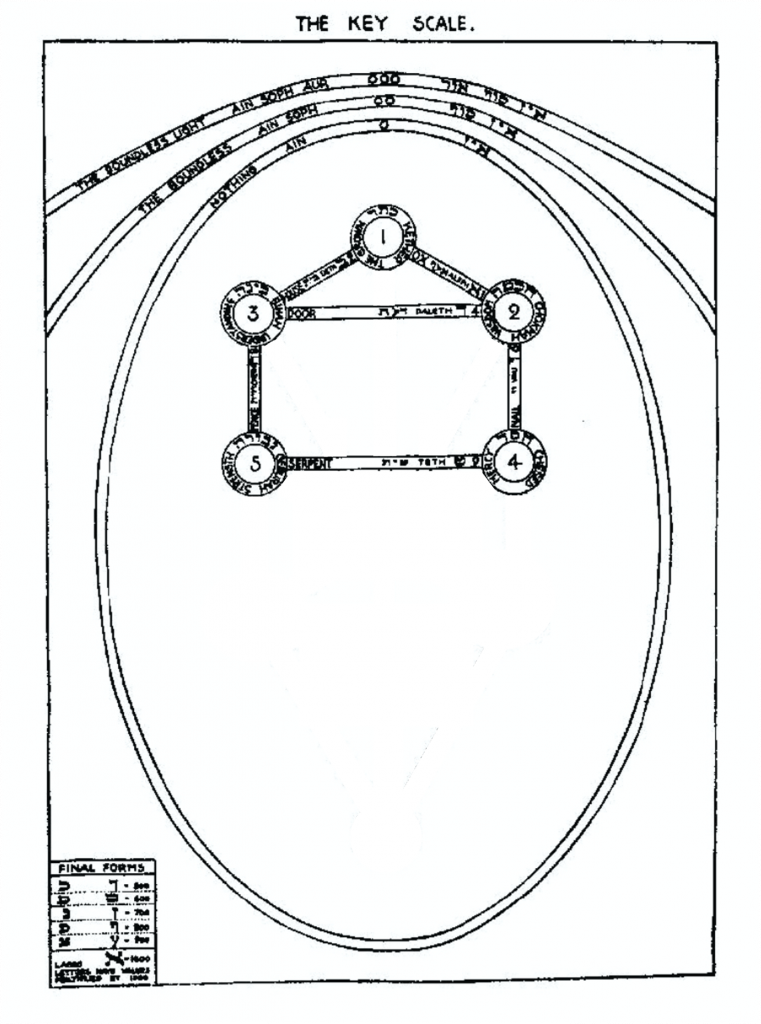
Six
If this thing has been somewhere, it can now be defined in terms of its past, present, and future, this is the centre point of the system and is numbered 6.
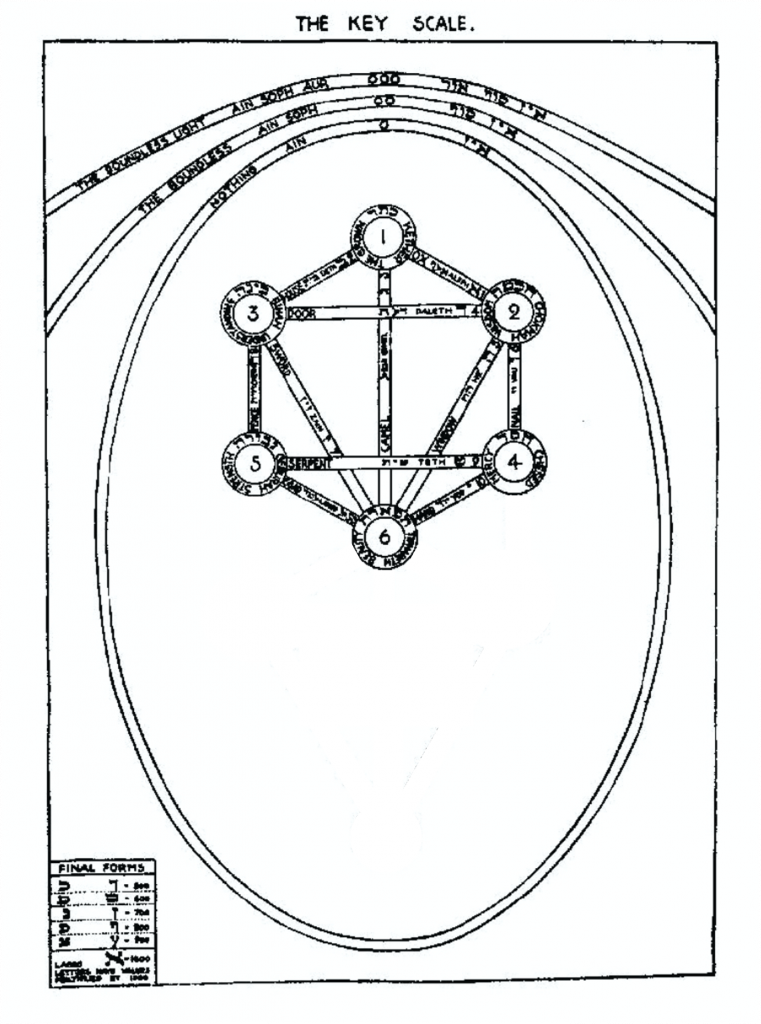
Seven, Eight, and Nine
To better define 7, 8 and 9, Crowley briefly moves away from the Qabalah and borrows concepts from Hinduism, those of Sat, Chit, and Ananda.
Seven
Ananda is the pleasure of being, the joy of being alive and aware of it, it is often translated as bliss.
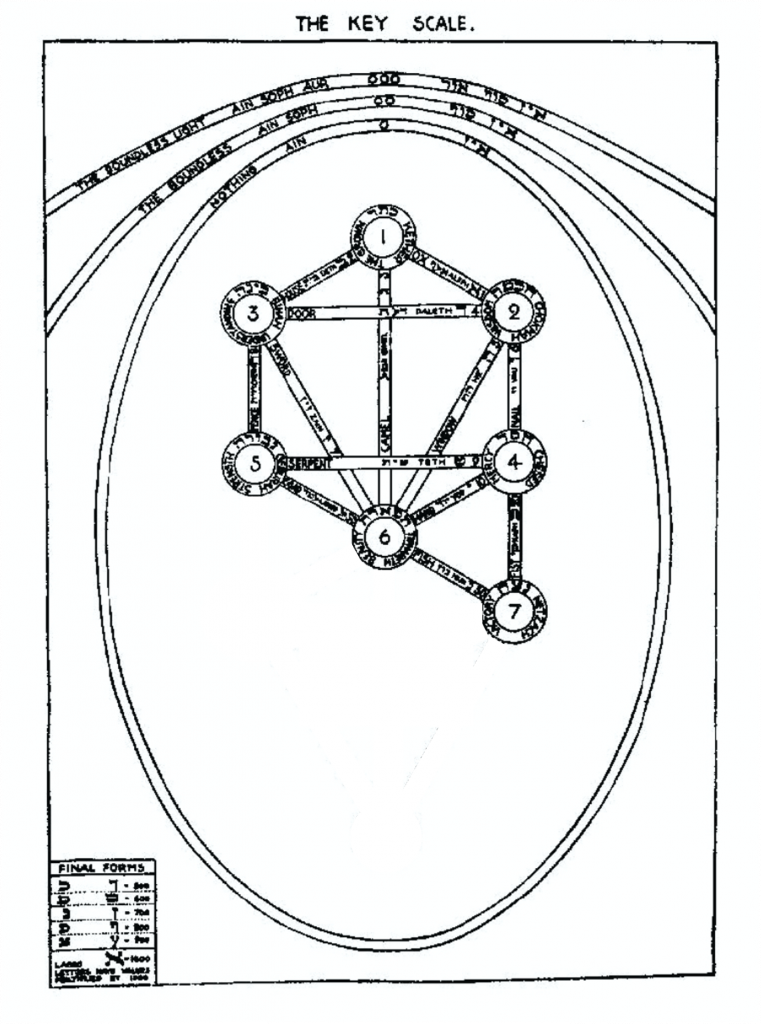
Eight
Chit is the concept of thought and intellect.
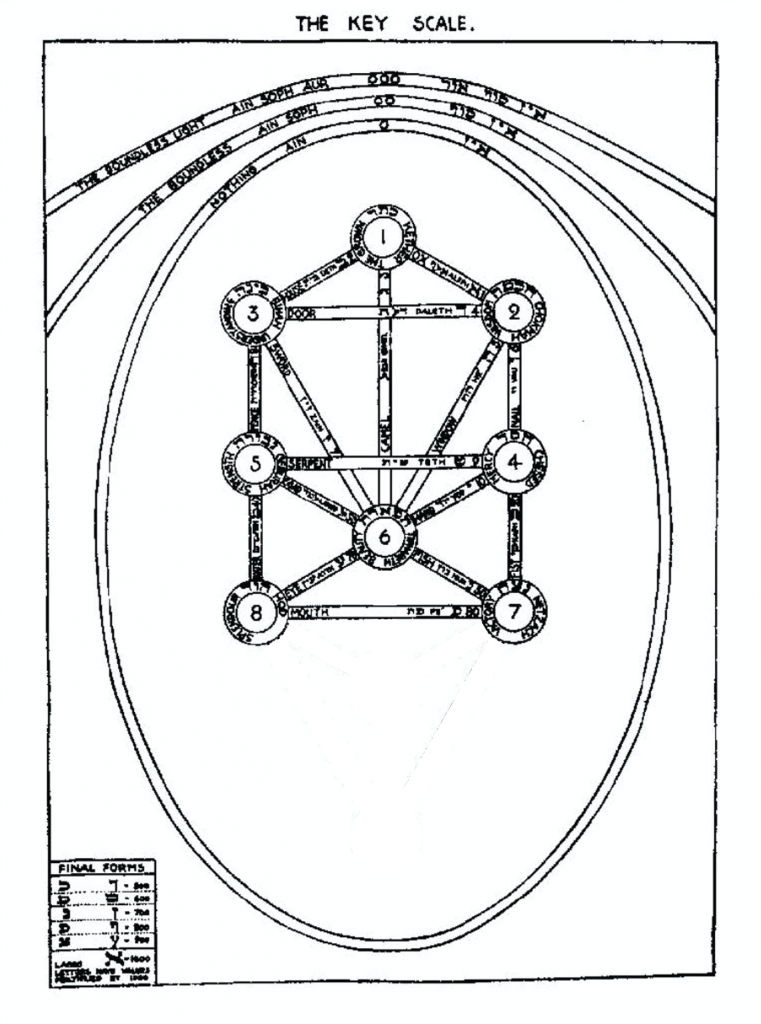
Nine
Sat is the concept of being, of consciousness.
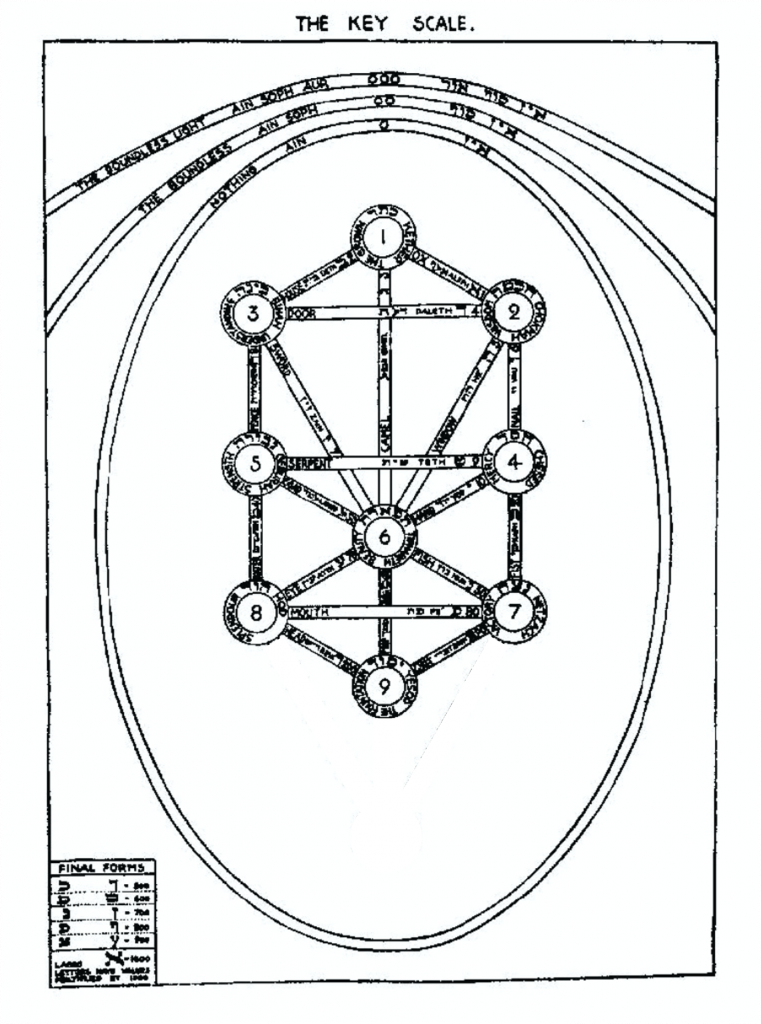
Ten
Finally, we have reality in the form of knowledge, ten.
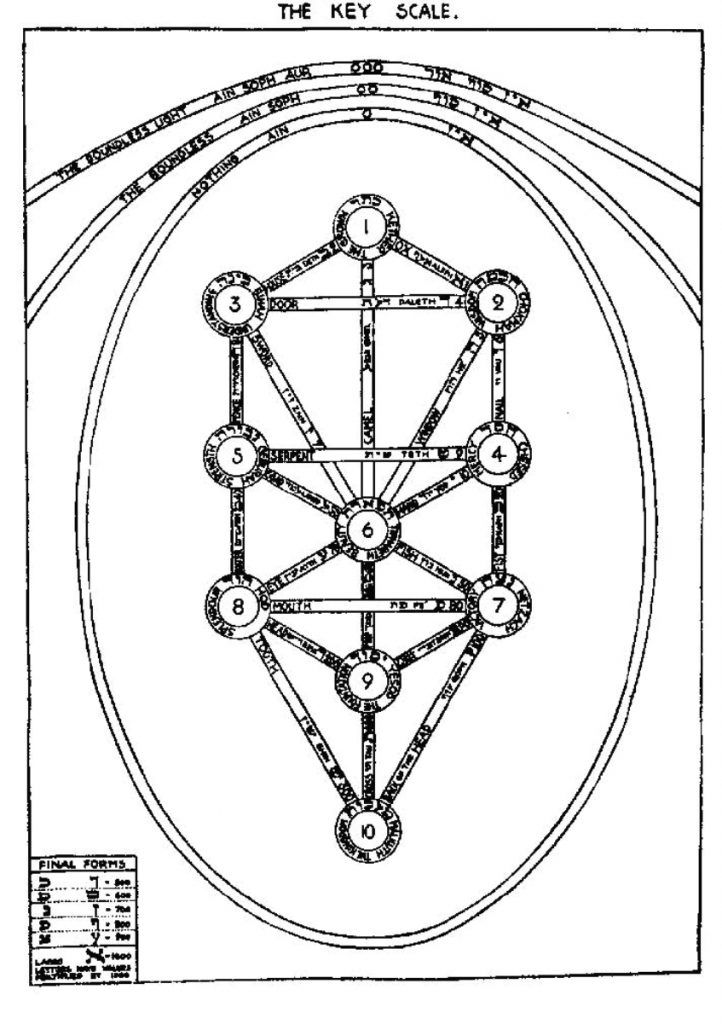
The elements, suits, and court cards
The tarot uses four court cards rather than 3 in a traditional deck of playing cards and these court cards are given various names depending on the deck. In the Thoth, Crowley makes the case that they should be called Knight, Queen, Prince, and Princess to represent the father, mother, son, and daughter. He puts forth the case that in the scientific method, something can only be created by adding or removing and that what is produced is different to its constituent parts. So the mother and the father exist but when combined they produce something different.
When discussing the elements, Crowley notes that when the ancient scholars referred to the elements, they were not being literal, water didn’t literally mean H2O, they were referring to the properties of liquid, its fluidity, its patience, its ability to shape the world when given enough time. It is important to remember this when considering a card’s element and the associated interpretation.
Elemental Associations
Each court card has an associated element as does each suit and they are as follows:
Knight – Fire
Queen – Water
Prince – Air
Daughter – Earth
Discs – Fire
Cups – Water
Swords – Air
Wands – Fire
Apophenia
At this point, I want to put on my sceptical head. If you have seen my other videos, you will know that I grew up around tarot cards with most of the women in my family practising some form of divination so I’m pretty open-minded but it would be remiss of me to talk about Aleister Crowley, a man who spent his life studying magik and mysticism and five years focusing on the study of the tarot and its supposed deeper meanings – without suggesting that he was suffering from apophenia.
There is no doubt that he was a highly educated and intelligent man, but have you ever studied so much that you start seeing references to the subject everywhere? How about compulsively playing a game and then seeing it in real life? Insert B99 clip.
Our brains developed the ability to see patterns and connections, and that ability is one of the reasons that we’re still clinging on at the top of the food chain. But when this gift runs wild, we can see connections that aren’t there, faces in the flames so to speak. At its worst, it can be a significant indicator of severe mental illness and the phenomenon is called apophenia. When I was refreshing myself on the phenomena, I read that it is considered the opposite of epiphany, both often have religious or mystic features, but one is considered true while the other is false.
Drugs are also something of an elephant in the room. Crowley was a great believer in the use of drugs, particularly psychogenics, to open the mind. He stated that they could “loosen the girders of the mind” but the truth is he experimented widely and became addicted to both heroin and cocaine. I’m not here to proclaim judgement, I know and have worked with many addicts over the years, I’ve seen the damage addiction can cause to both body and mind and one has to question whether these are the visions of a messenger on earth or the ramblings of someone in the throws of drugs and madness. There is a section in the book of thoth which seems to be direct dictation of his visions, it’s worth reading and forming your own opinions.
The sheer amount of evidence he presents is definitely compelling, but I can’t help thinking about conspiracy theories and how compelling they can be, hell, some of them have even been proven to be true!
Modifications to the Tarot deck
Crowley believed that a secretive group – the secret chiefs – gave certain messengers the knowledge of the universe through the Tree of Life and the tarot. He reasoned therefore that they might wish to modify the deck from time to time depending on the Aeon and the personal and societal context of the cards. For example, the hierophant became the pope, and the high priestess was for a time, Pope Joan. He believed he was in contact with these secret chiefs and that they gave him the understanding to make modifications to the traditional tarot in order for them to become the Thoth tarot.
In the Thoth tarot, Crowley links the cards to the 22 letters, three mother letters and seven double letters of the Hebrew alphabet, and the 12 signs of the zodiac and the elements. He makes the case for some letters to have double relevance grouping the elements fire and spirit and the planets Earth and Saturn.
The Trump Cards
In the interests of time I am going to focus on the key attributes of each card and as always I recommend you read the book of thoth for a deeper understanding of Crowley’s interpretations of each card.
0 – The fool
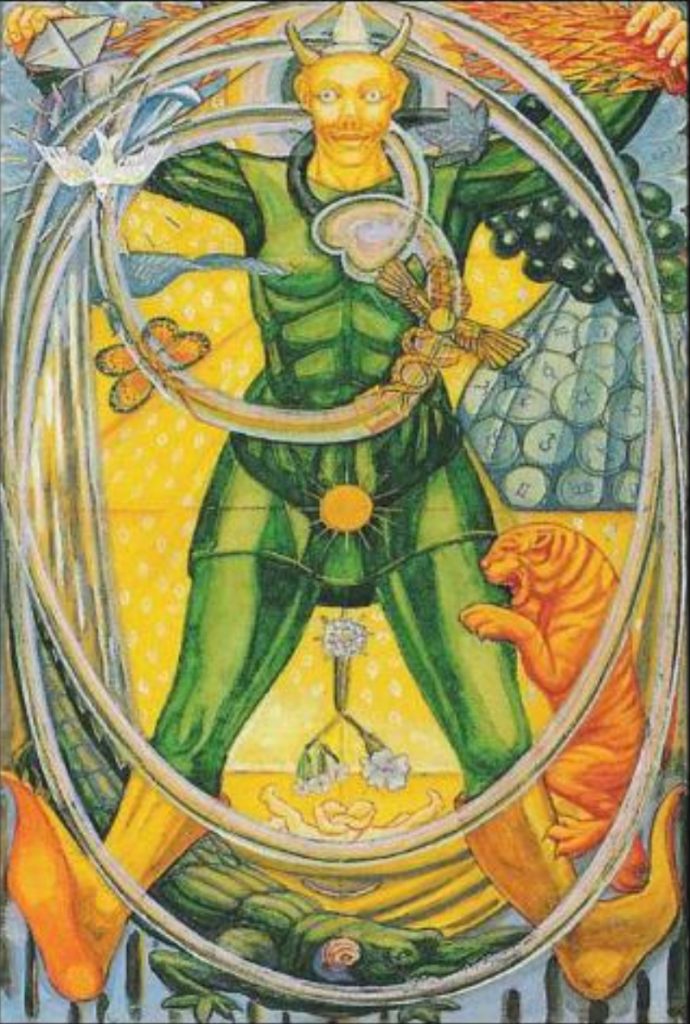
The fool is attributed to the letter Aleph which means Ox. It is the first of the three mother letters. Triads are very important in the Thoth, notably Fire, Water, Air; Father, Mother, Son; Sulphur, salt, mercury; rajas, sattvas and tamas. But the key feature of this card is its number, zero, it represents the negative or abyss above the Tree of Life. Crowley gives many reasons why this card should be considered the beginning of everything, including linking the medieval name of Le Mat to Maut, the Egyptian vulture goddess who has a spiral on her neck, this spiral he believes, represents the galaxy. He makes the case that this card is the father and mother of everything due to a fertilised ovum being sexually neutral, it is only when some external factor is added that gender is physically assigned, likewise, the feminine and masculine elements of things always occur in balance.
In the book of Thoth, Crowley gives a comprehensive overview of the fool in fairy tales, myths, legends, religion and received wisdom and its association with the spring which mentally most of us view as a fresh start. I highly recommend reading the book in its entirety but specifically the section on “The formation of the tetragrammaton” for more on the whole subject.
The key point to take from it is the cyclical nature, the ouroboros, self-perpetuating nature of the card. The wandering fool is born of air and fire and contains the madness of a genius. It is important to recognise the duality of contradiction that each contains within it its opposite or contradiction. Each aspect of the image in the card is representative of an aspect of the fool as told in fairy tales, myths, legends, religion and received wisdom.
I – The Juggler
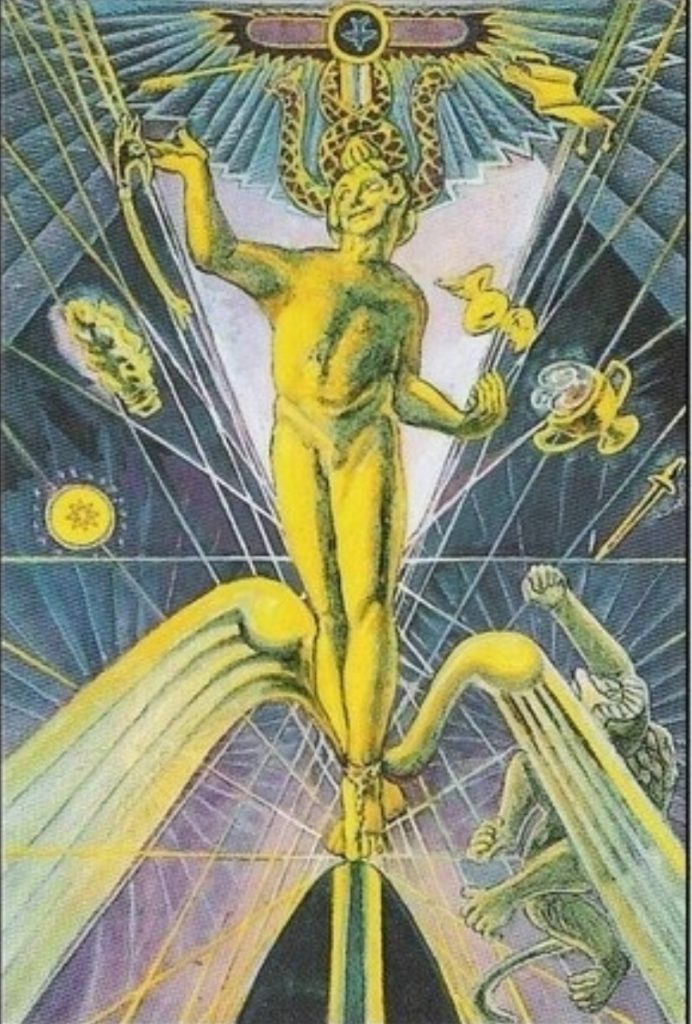
The juggler is referred to the letter Beth which means house and is attributed to the planet Mercury. Crowley believed that the speech of creation was silence, and this card is the manifestation of the ten indefinable ideas and thus represents continuous creation. The emphasis is on the creative and dualistic character on the path of Beth. The juggler is the messenger of the Gods.
II – The High Priestess
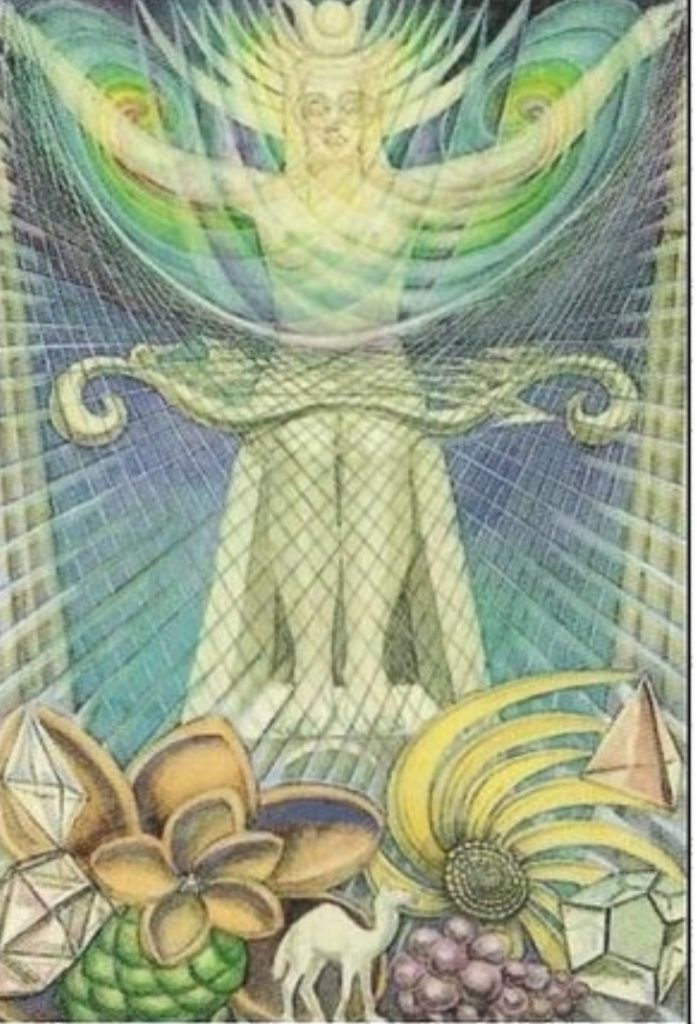
This card refers to the letter gimel, which means camel and refers to the moon – the moon being a feminine symbol, it is a symbol of the second order corresponding to the sun as the yoni corresponds to the lingam. While the two previous cards are concerned with the nature above the abyss, the high priestess is the first to connect the supernal triad – ain, ain soth and ain soth aur – with the hexad, the ten below. She makes the direct connection between the father in his highest aspect and the son in this most perfect manifestation. That she is clothed only in light represents the veil that hides the spirit, she is the truth and she hunts by enchantment. She is potentially the goddess of fertility, the idea behind all form and the influence of the supernal triad below the abyss. Crowley makes particular mention of the three consecutive letters, gimel, daleth and he which show the feminine symbol – yin – in three forms composing the triune goddess. This trinity is immediately followed by the three corresponding and complementary fathers, vau, tzaddi and Yod.
III – The Empress
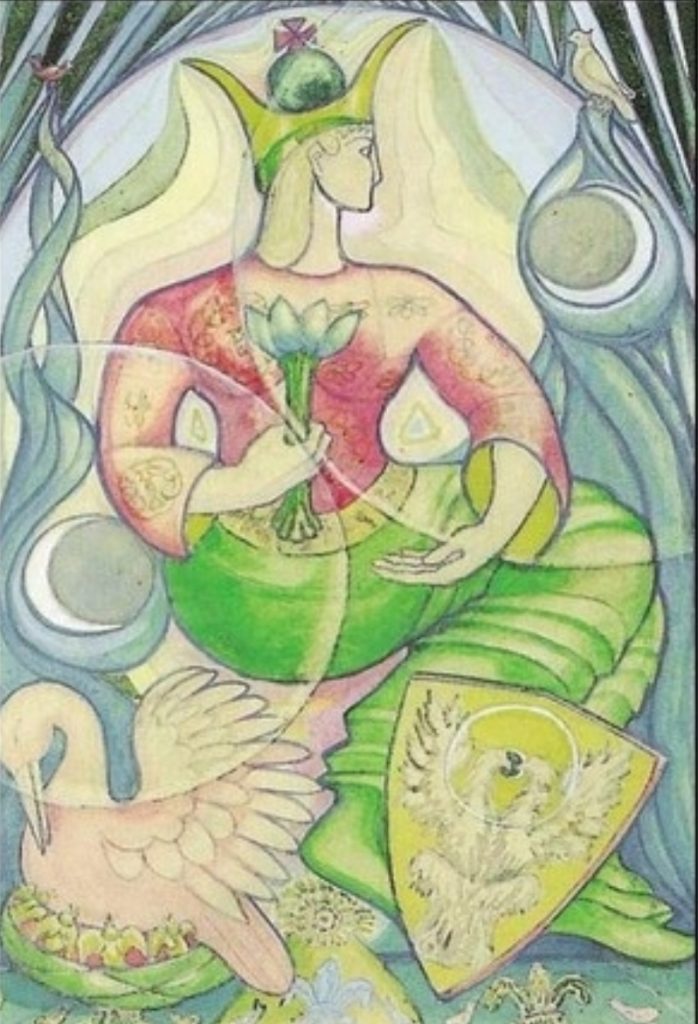
This card is attributed to the letter daleth which means door and refers to the planet Venus, while superficially the complement of the emperor, her attributions are much more universal. Daleth is one of three paths which are altogether above the abyss. Crowley states it is impossible to summarise the meanings of the symbol of the woman because she recurs in infinitely varied forms. Here she combines the highest spiritual with the lowest material qualities and thus represents the alchemical form of salt. Salt is the inactive principle of nature; it requires energy from sulphur to maintain the equilibrium of the universe. Each of the symbols shown in the card is representative of an aspect of femininity. In this card there is no contradiction, only the opposition required to attain balance – as shown by the revolving moons. There are symbols of the continuity of life and a blood inheritance which binds all of nature. There is no break between light and darkness. There are symbols of the initial perfection of nature and the final perfection of art. Crowley calls this card the gateway to heaven but alerts students to not get carried away with any singular manifestation or symbol but instead to concentrate upon the whole.
IV – The Emperor
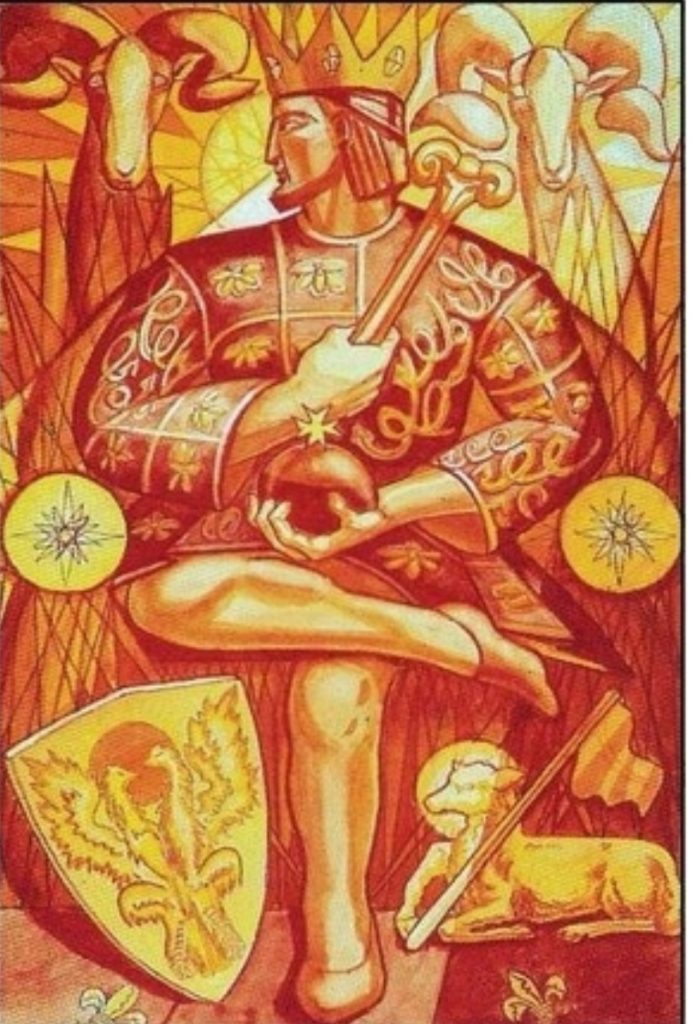
This card is attributed to the letter Tzaddi and refers to the zodiacal sign of Aries, it is therefore a combination of energy in its most material form and authority. The combination of the rams and the lamb shows the wild, courageous, and often lonely nature of the ram contrasted with their docile, cowardly cousin. Crowley calls this the theory of government.
The emperor also represents the alchemical symbol for sulphur, the fiery male universal energy. The quality of this power is a sudden, violent but impermanent activity which, if it persists too long, burns, and destroys, Crowley contrasts this with the creative energy of Aleph and Beth noting this card is below the abyss.
The orb surmounted by the Maltese cross signifies his energy has reached a successful issue and that his government has been established. The final symbol to note is the white light which indicates his position on the Tree of Life and that his authority is derived from creative wisdom and then exerted on man.
V – The Hierophant
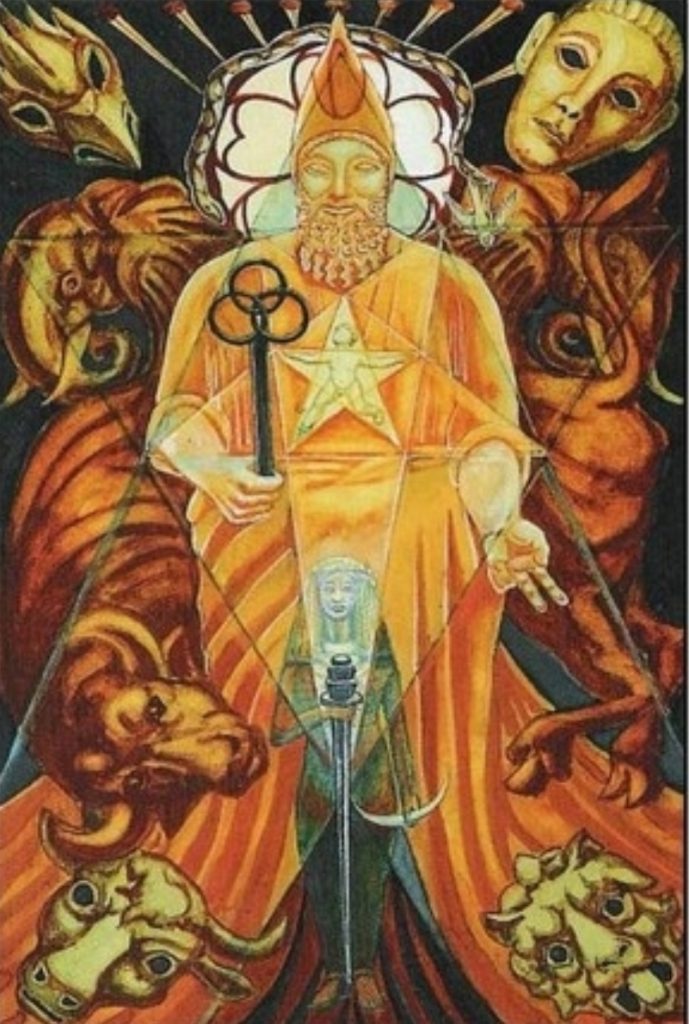
This card is referred to the letter Vau which means nail. There are nine nails at the top of the card fixing the bay window behind the hierophant. The card also refers to Taurus, the elephants represent the nature of Taurus while the hierophant is seated upon a bull. The four beasts guard every shrine. But the key feature is the most essential of all magical work, the unity of the macro and microcosms.
Crowley believed that time can be bracketed into aeons of 2000 years. He believed that we were at the start of a new aeon, the aeon of Horus or the child. Thus, the pentagram at the centre represents the dancing child and symbolises the new aeon. This aeon has supplanted the previous aeon, that of the dying God Osiris, which governed the world for the last 2000 years. He notes that the hierophant’s rhythm is such that he moves only at intervals of 2000 years.
The woman before him is representative of the planet Venus but as this is a new aeon, she is no longer a vehicle for her male counterpart, she is armed and militant. Crowley states that it is impossible to explain this card thoroughly because it is so early in the new aeon, only the course of events can show how the new current of initiation will work out. He notes that while the hierophant appears benign and the child appears happy, the initiator could be seen as indulging in a sadistic joke at somebody’s expense.
VI – The Lovers (or the brothers)
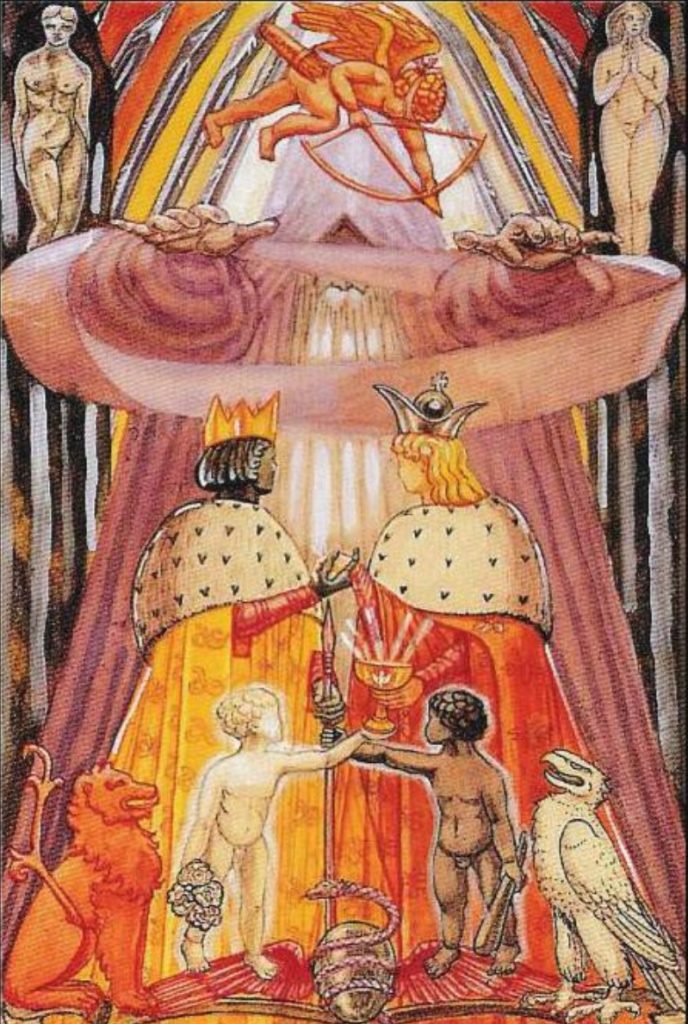
Whew, there’s a lot going on in this one. This card and its twin, 14, art are the most difficult to interpret. This card refers to Gemini, the twins and the corresponding Hebrew letter is Zain which means sword. Together with Art, the lovers compose the comprehensive alchemical maxim solve et coagula – analysis and synthesis, break apart and recombine. According to Crowley, this card shouldn’t be called the lovers but should in fact be called the brothers because it depicts Cain and Abel along with their mother Eve.
This card also symbolises Newton’s third law, that each action has an equal and opposite reaction. The formulation of any idea creates its own contradiction at almost the same moment, and this is necessary to preserve the equilibrium of the universe.
This card represents the creation of the world, so important was this secret that the initiates who used the tarot during the aeon of Osiris superseded it and called it the children of the voice, the oracle of the mighty gods – catchy huh. They were concerned with creating a new universe of their own using alchemy. The subject of this card therefore is analysis followed by synthesis.
The hooded figure at the centre of the card is another form of the fool and the hermit, his shroud signifies the ultimate reason of things lies in a realm beyond intellect. The two figures are being joined in a hermetic marriage and analysis is the continuous see-saw of contradictory ideas, of duality.
The red lion and white eagle symbolise the male and female principles in nature. The egg represents all life, and its colour shows the cooperation of these male and female figures.
As a whole, it is a depiction of the equilibrium necessary to begin the ‘great work’.
VII – The chariot
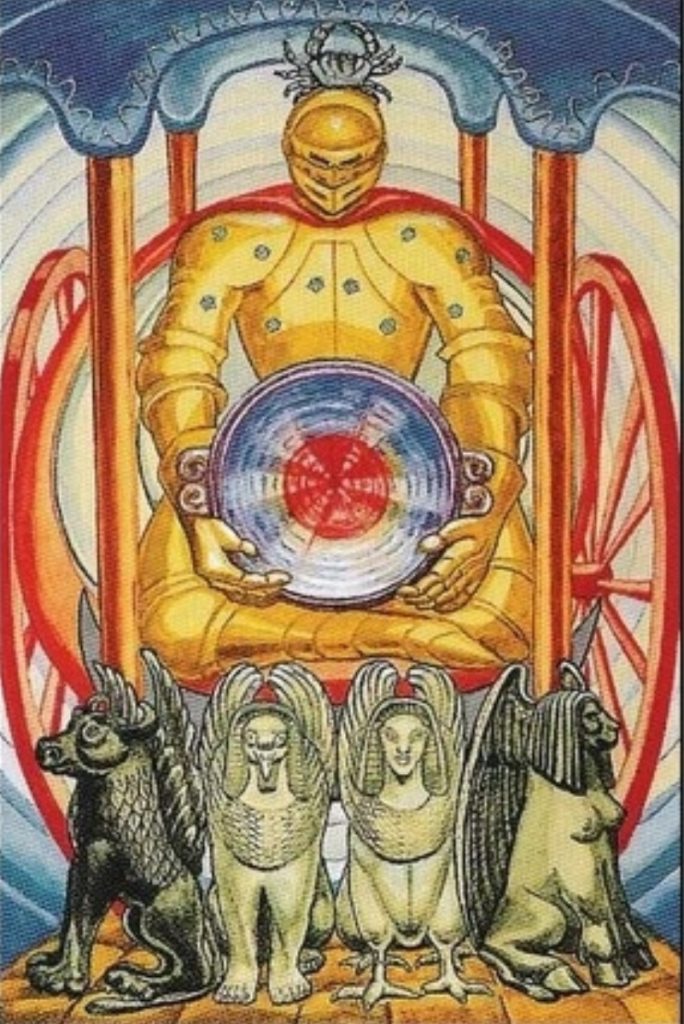
This card refers to the sign of cancer which is the cardinal sign of the element water and represents the first keen onrush of that element. It is also the path that infers the influence of the supernals through the veil of water upon the energy of man and so inspires him. It corresponds to the Hierophant which sits on the opposite side of the Tree of Life.
Note the charioteer is throned on the chariot rather than conducting, this is because the whole system of progression is perfectly balanced and he need not intervene, his function is only to carry the holy grail.
VIII – Adjustment
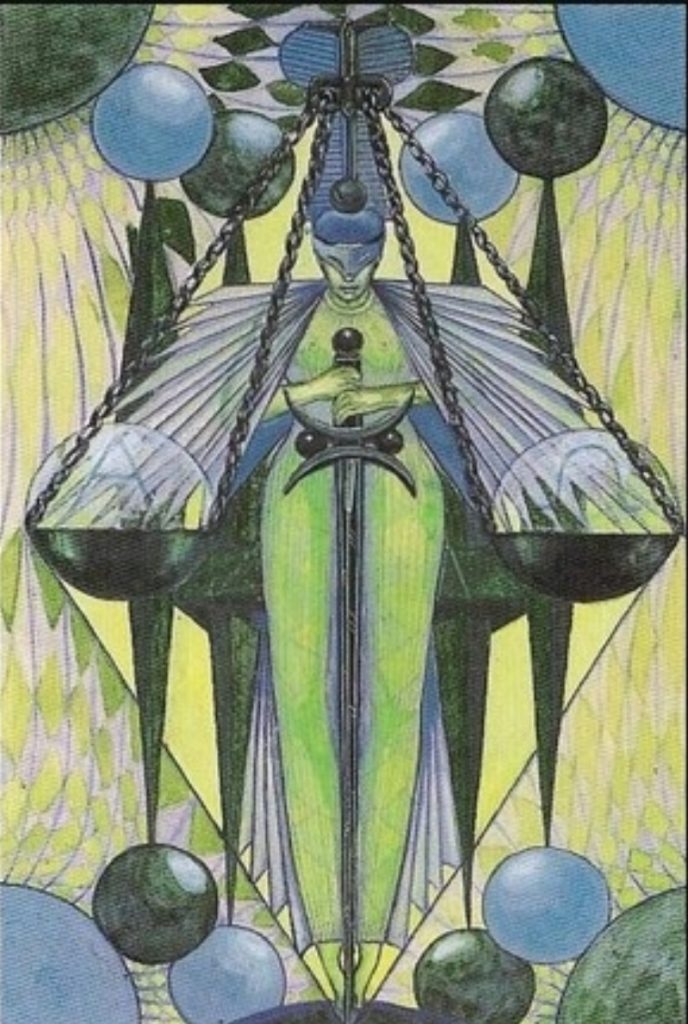
This card is known as justice in other decks, but Crowley argues that there is no justice in nature, that justice is a purely human concept, however, nature IS exact. The card represents Libra, ruled by Venus and in it Saturn is exalted, the equilibrium of all things is symbolised here.
This is the final adjustment in the formation of the tetragrammaton, where the daughter, redeemed by her marriage with the son is set upon the throne of the mother.
Adjustment is the feminine counterpart of the fool and is represented by the letters aleph lamed. The figure is dancing and is adorned with various symbols including justice, life, and death. She holds dominion over every element of disequilibrium in the universe. The spheres represent alpha, the first and omega, the last, they balance perfectly. The diamond which is formed by the figure conceals the vesica piscis, through which all experience is sublimated, adjusted, and passed on to its next manifestation.
Crowley states that this card represents a woman satisfied, the equilibrium stands apart from any individual prejudices. She assesses the virtue of every act and demands exact and precise satisfaction. He states that she is the embodiment of karma.
IX – The hermit
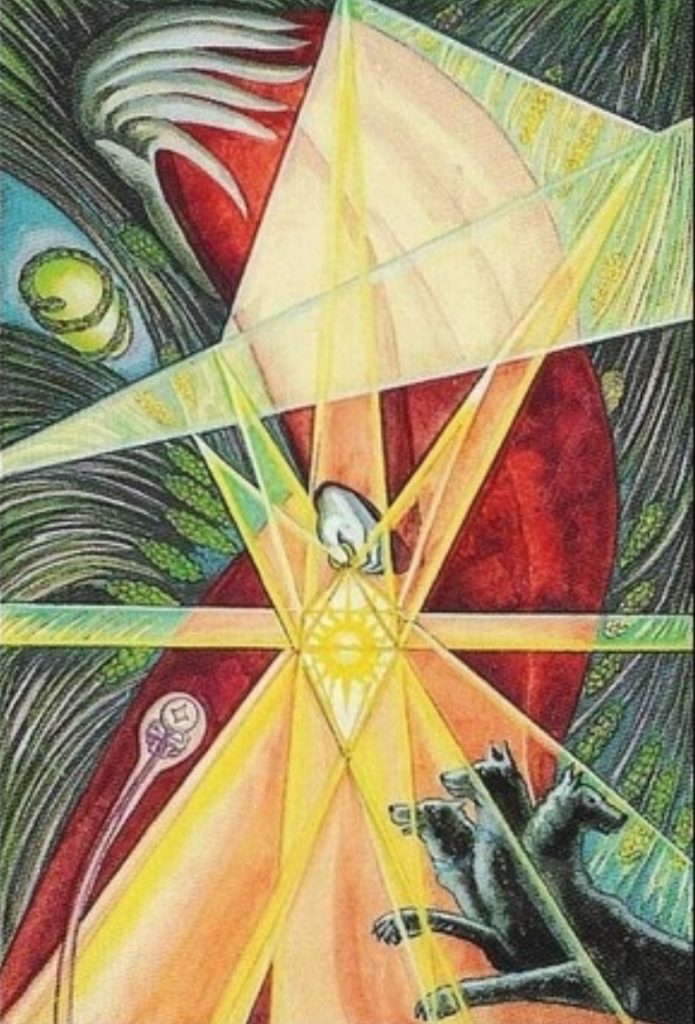
This card is attributed to the letter Yod which means hand, yod is the foundation of all the other letters in the Hebrew alphabet. Yod is the first letter of the tetragrammaton and symbolises the father, the creator of all worlds. In the lamp is the sigil of the king of fire because Yod is the secret fire. He is not only creative but is the fluidic essence of light which is the life of the universe.
The highest symbolism in this card is fertility which is reflected in the attribution of the card to the sign of Virgo and it is the mode of the fulfilment of the great work. It is manifestation and method.
X – Fortune
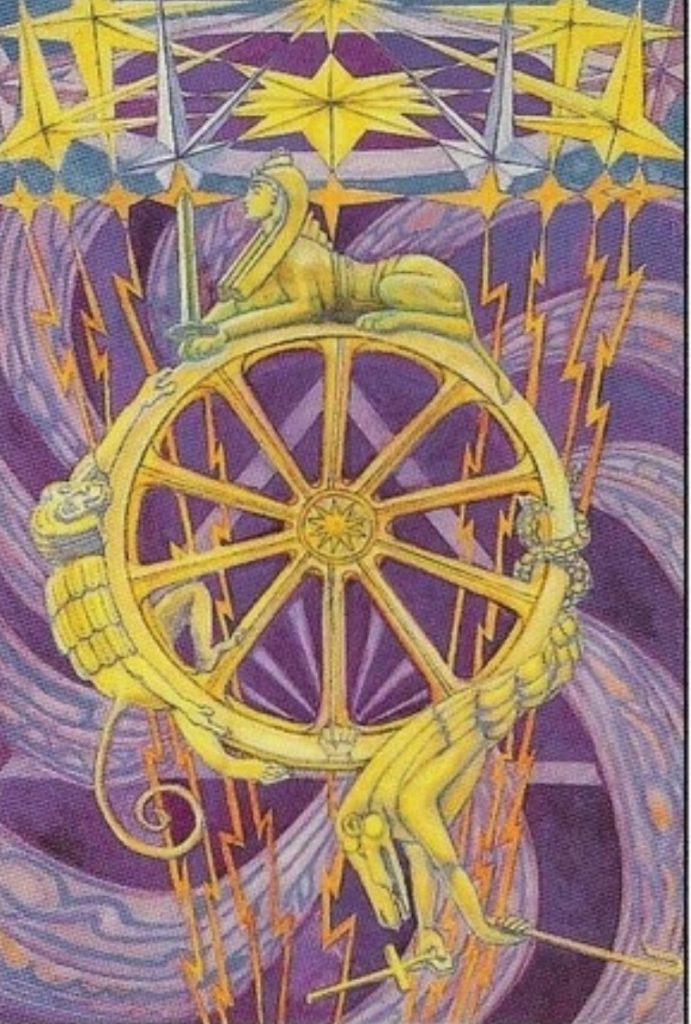
This card is attributed to the planet Jupiter and the letter Kaph which means the palm of the hand. Jupiter represents the element of luck, the incalculable variable.
This card represents that the universe is in a state of continual change, the spokes of the wheel indicate the governance of physical affairs. The three figures on the wheel represent the sphinx, hermanubis (hermanubis was formed when Anubis merged with the Greek god Hermes) and Typhon, which in turn represent the three forms of energy which govern the movement of phenomena. Crowley states that the qualities of these three figures can be found in the Hindu gunas – sattvas, rajas, and tamas. Tamas is darkness, inertia, sloth, ignorance, and death. Rajas is energy, excitement, fire, brilliance, and restlessness and Sattvas is calm, intelligence, and harmony. Hindus believe that within everything is a varying mix of these three qualities. There is a Hindu aphorism “the gunas revolve” which means that nothing can remain in a phase where a single guna is dominant. In alchemy, the elements of salt, sulphur and mercury have very similar qualities to the gunas.
The Sphinx is composed of the four kerubs, the bull, the lion, the eagle, and the man and they correspond to four magical virtues, to know, to will, to dare, and to keep silence. It represents the element sulphur and temporarily sits atop the wheel.
Hermanubis represents mercury and the simian element of this composite god is dominant.
Typhon is the element of salt.
XI – Lust
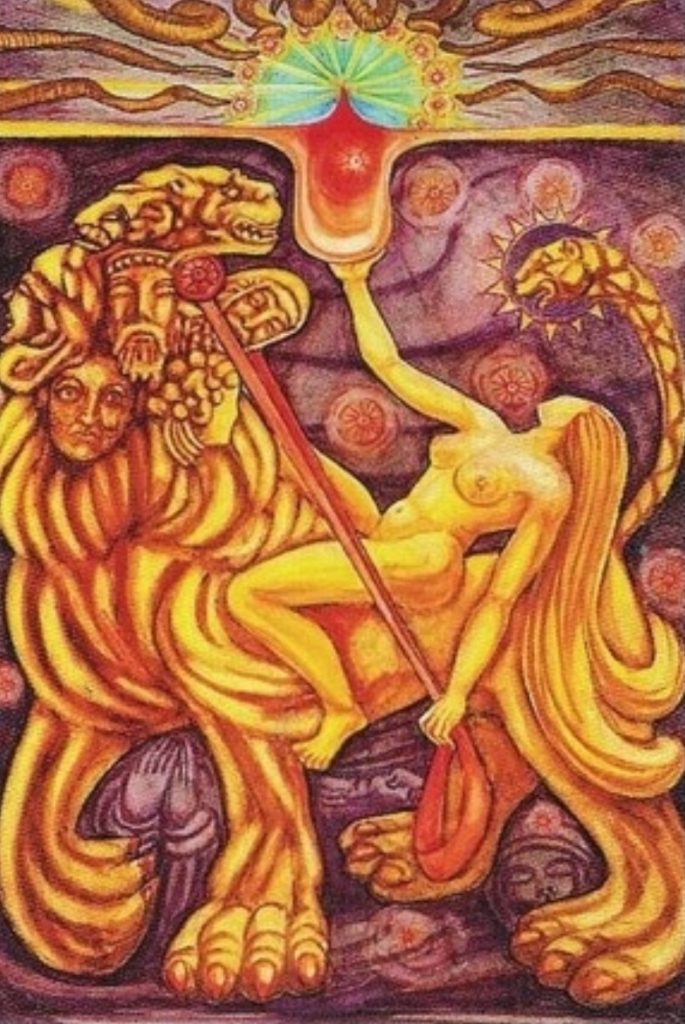
This card is known as strength in the rider Waite and other decks but according to Crowley, it implies far more than just strength in the ordinary sense of the word. Lust not only implies strength, but the joy of that strength exercised, it is vigour and the rapture of vigour. It is assigned to the Leo, is the kerub of fire and is ruled directly by the sun. Its Hebrew letter is teth, the serpent. It is the most powerful of the 12 zodiacal cards and represents the most critical of all of the operations of magik and alchemy. Crowley posits that the seers of the previous aeon regarded our current aeon with horror and fear, they regarded every change as a catastrophe and as such the interpretation of this card was often wrong. The woman on the card may be regarded as a form of the moon, fully illuminated by the sun and intimately united with him in a manner to produce the incarnate of the representative of the lord of the aeon. In ecstasy she rides the beast, passionately holding his reins and holding aloft her cup while the lion is aflame with lust. This signifies primitive creative energy, independent of reason.
XII – The hanged man
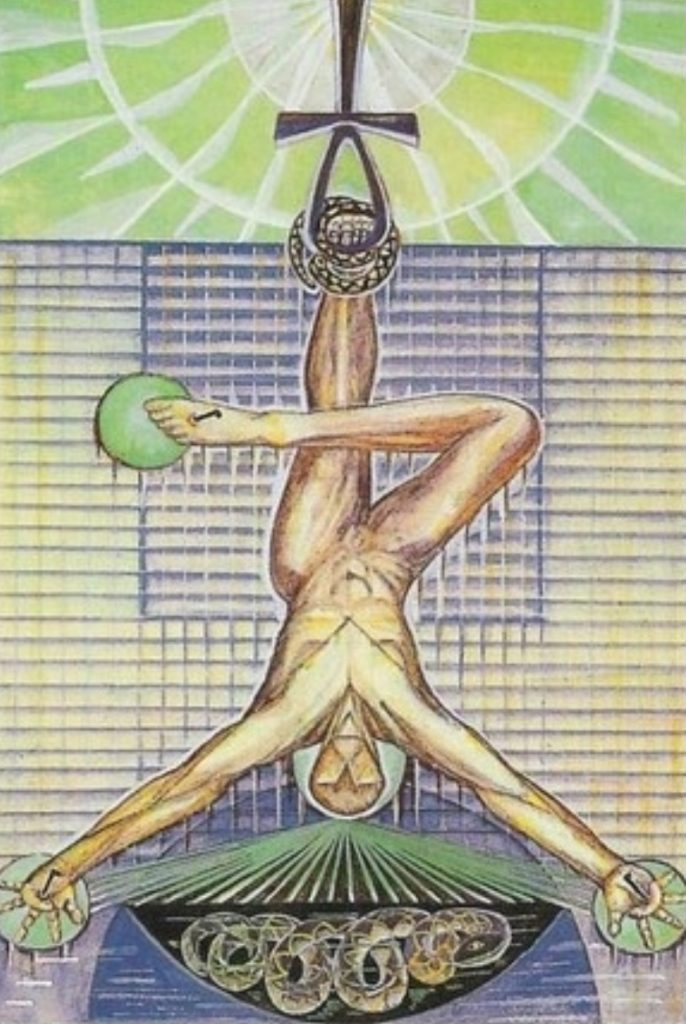
This card is attributed to the letter Mem and represents the element of water, more specifically the spiritual function of water. The shapes of the figure and the cross represent the descent of light into darkness in order to redeem it. Crowley believed that any interpretation of this card related to sacrifice was wrong, stating instead that it is the card of the dying god, it is merely a memorial which states if ever things get bad like that again, in the new dark ages which appear to threaten, this is the way to put things right. If things are to be put right, it follows that they are very wrong, Crowley argues that the aim of mankind should be certainty and ecstasy. He states that every human is a star and possesses boundless wealth. In order to bring them to understand their starry heritage it is necessary to behave in a manner that treats all, including animals and children with absolute respect. It is necessary to go round and round this wheel of symbolism until one can partake of the sacrament and accomplish the great work.
XIII – Death
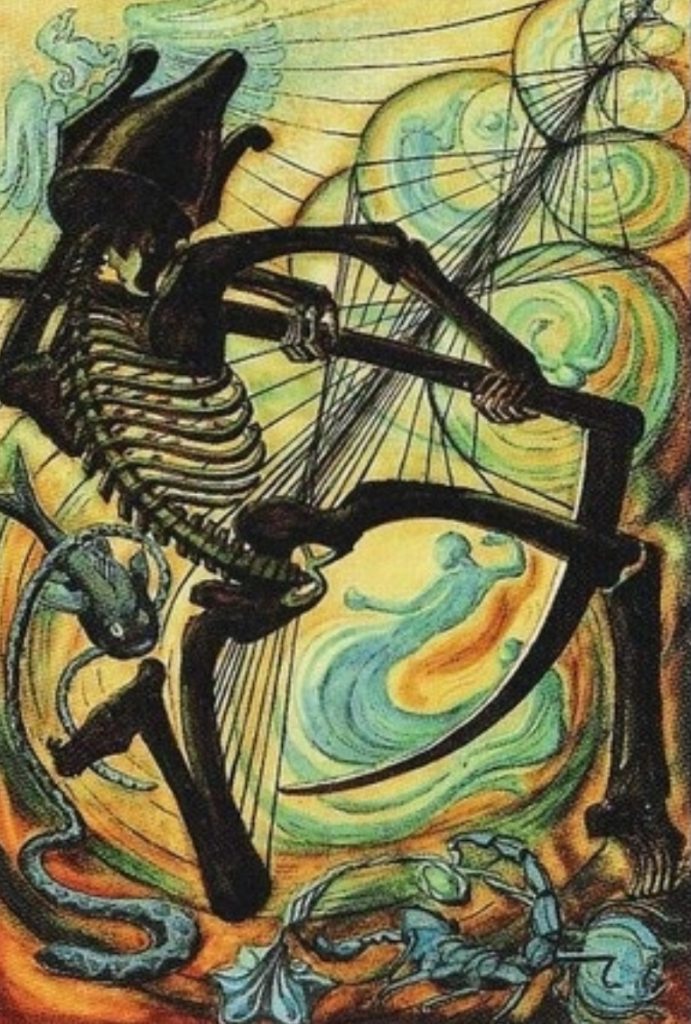
This card is attributed to the letter Nun which means fish, the symbol of life beneath and travelling through the waters. It refers to Scorpio, which is ruled by Mars, the planet of fiery energy in its lowest form. It represents putrification in the alchemical sense, that is the series of chemical changes which develops the final form of life from the latent seed.
Like Lust, this is one of the most powerful zodiac symbols, but it is much more complicated. It is divided into three parts symbolised by the scorpion which was supposed by early observers of nature to commit suicide when finding itself ringed with fire or in another desperate situation. This represents putrefaction in its lowest form. The strain of the environment has become intolerable, so the element willingly subjects itself to change. The middle interpretation is that of the serpent, the sacred lord of life and death, and the rhythmic undulation of the two phases. The highest aspect of the card is the eagle which represents exaltation above solid matter.
The card itself represents the dance of death; the skeleton and scythe being important Saturnian symbols, Saturn representing the elemental nature of things which are not destroyed by the ordinary operations of nature. Crowley argues that it was a corruption borne by the misunderstanding of the cult of the dying god that rendered death into a senile and fiendish symbol.
The sweep of the scythe creates bubbles which create new forms, see the fish symbolic of new life. The card is a compendium of universal energy in its most secret form.
XIV – Art
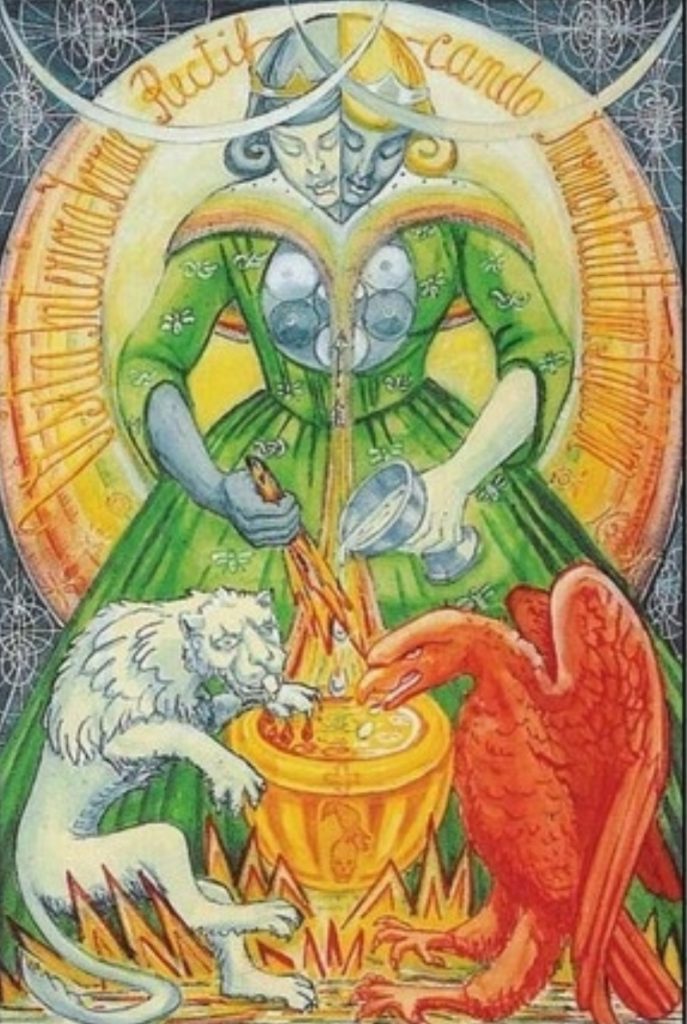
This card is the fulfilment of Gemini, it pertains to Sagittarius, the opposite sign to Gemini in the zodiac. In other decks this card is named temperance.
Sagitarius is the archer and in it’s most simple form, this card is a representation of Diana the Huntress, Diana being one of the Lunar Goddesses. It also represents the consummation of the royal marriage shown in the Lovers. The two figures united in a single persona, the red lion has grown and become white and the white eagle, also grown, has become red. The equilibrium has changed within the figure, the opposing colours of head and arm indicate the left hand is guided by the right head and vice versa. The burning blood poured by the right hand is extinguished by the water poured by the left. Also symbolised by these elements is the desire of one incomplete element to assimilate its equal and opposite. The great work is begun with the mingling of these elements. Foreshadowed in this card is the final stage of the great work, the Latin which translates to ‘visit the interior parts of the earth: by rectification, thou shalt find the hidden stone’. This again links to alchemy, the acronym for vitriol (when written in Latin), vitriol being the universal solvent. Crowley makes the case that we are ignorant of the ways of the alchemists and as such view them as ignorant, but with an understanding of their beliefs and methods some of their knowledge can be revived.
The arrow piercing the rainbow is of supreme importance as it is the symbol of directed will, much as the philosopher’s stone is the vehicle of the true will of the alchemists.
XV – The Devil
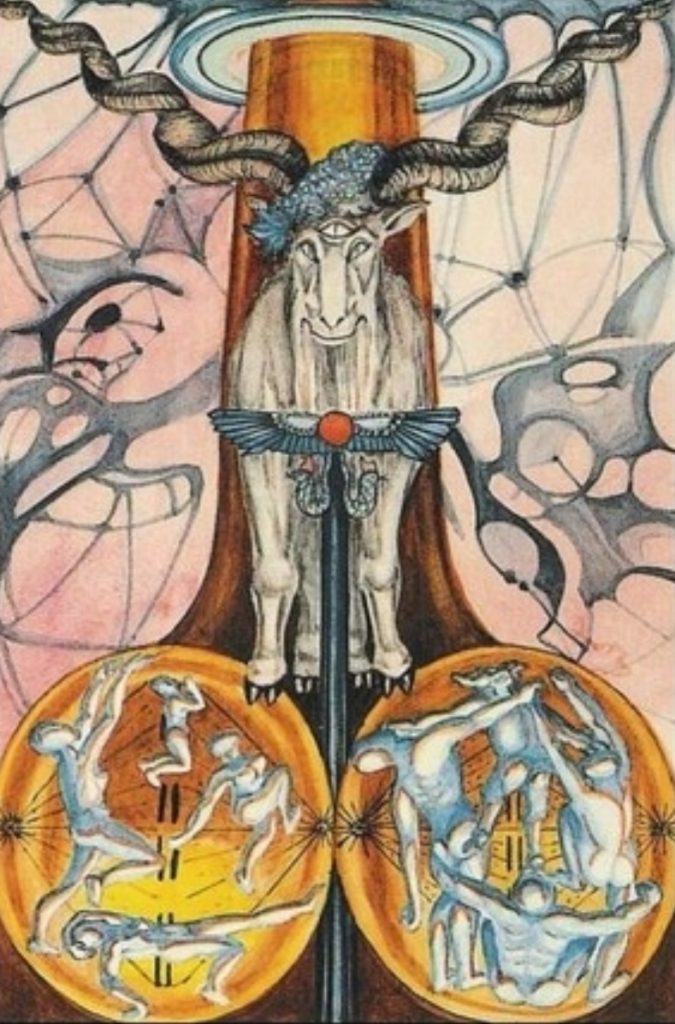
This card is attributed to the letter Ayin, which means eye and refers to Capricorn in the zodiac. Eliphaz Levi redrew the card and identified it with Baphomet. Cast your mind back to the Naples arrangement and how each concept necessitates the others. Similarly, Crowley argues that on the Tree of Life death and the devil are symmetrically placed, they lead from Tiphareth – human consciousness to the spheres in which thought, and bliss are developed, between them, Art leads to the sphere that formulates existence. Therefore, these three cards together are the processes by which an idea manifests as form.
This card represents creative energy in its most material form; Capricorn occupies the zenith of the zodiac; it is the goat leaping with lust upon the summits of earth. It also represents Pan Pageanter, the all begetter. It is the divine madness of spring already seen in the meditative madness of winter. This card represents masculine energy at its most masculine. In every symbol in the card there is an allusion to the highest and most remote things and note the spirals, representative of the movement of energy and the galaxy.
XVI – The Tower (or War)
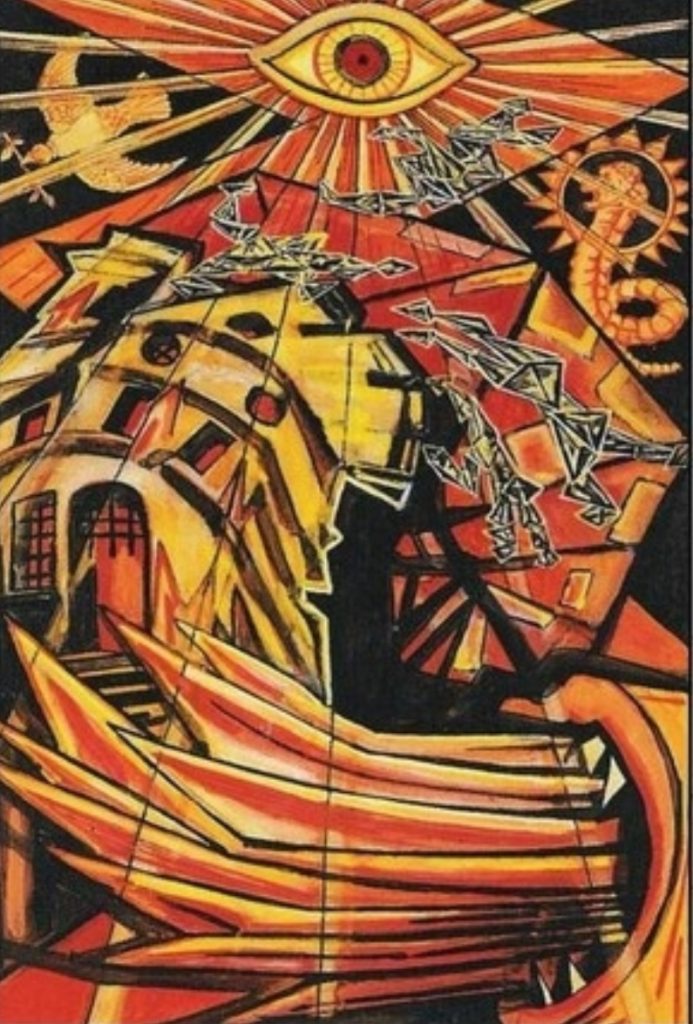
This card is attributed to the letter Pe which means mouth and refers to the planet Mars. At its simplest, it refers to the manifestation of cosmic energy in its grossest form. The destruction of existing material by fire is a preface to the last judgment or the coming of a new Aeon and as such it indicates the essential quality of the lord of the Aeon. Crowley talks about the belief that to attain perfection all things must be annihilated and the freedom from the confines of life. The eye of Horus or Shiva opening is how the universe is destroyed according to some belief systems. The serpent and the dove are representative of the duality of the will to live and the will to die, the feminine and masculine impulses but rather than being contradictory they are phases of a single manifestation of energy.
XVII – The Star
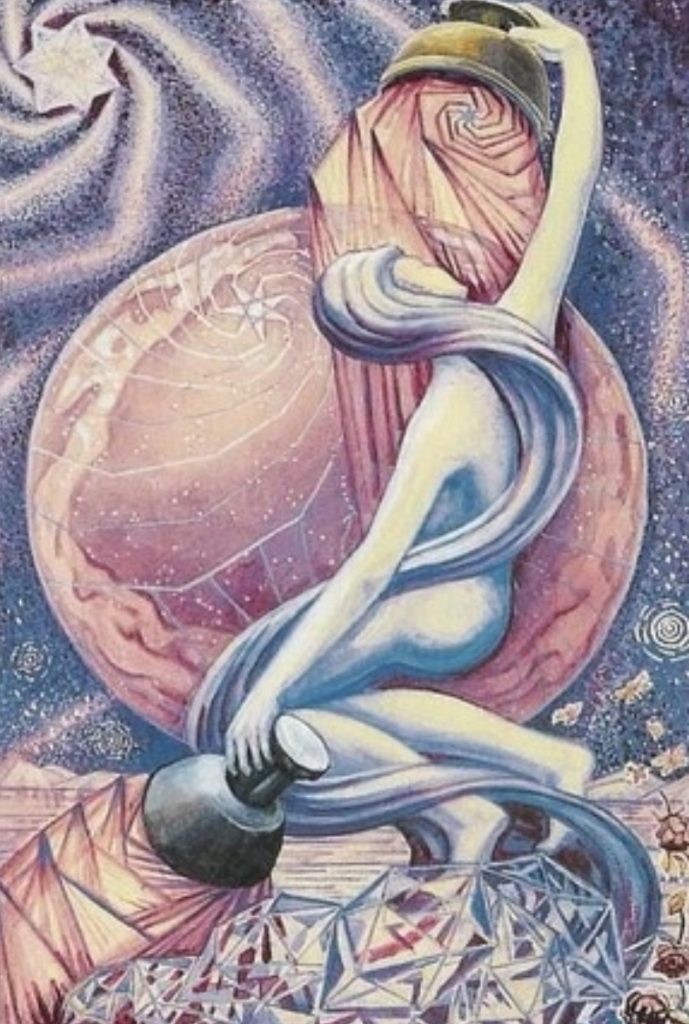
This card is attributed to the letter He and refers to the sign Aquarius, the water-bearer. It also represents Nuith, our lady of the stars. She pours upon herself ethereal water, which is also milk, oil, and blood indicating the eternal renewal and inexhaustible possibilities of existence and from her lower hand she pours the immortal liquor of her life – amrita, ambrosia, universal medicine, blood of the grail or nectar. The water that it flows to is the sea of Binah, a manifestation of Nuit on the lower plane.
I’ve so far refrained from using the term scarlet woman as it has very different connotations in general parlance than when used in relation to Crowley and to delve into that would be a distraction from what we are looking at here. Suffice it to say for our purposes that she is a sacred messenger entrusted with great secrets.
Once again, we see the spiral motif which Crowley suggests indicates the hawk-headed Lord of the current Aeon as well as the shape of the galaxy and perhaps the universe itself.
XVIII – The Moon
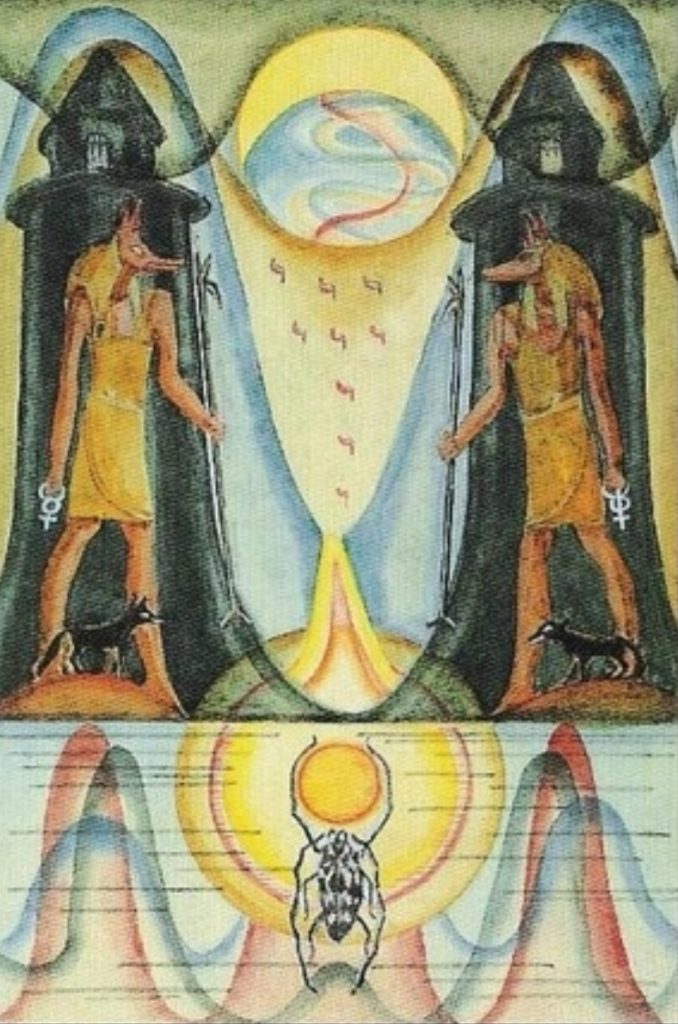
This card is attributed to the letter Qoph which represents Pisces in the zodiac, it is the moon. Pisces represents the last stage of winter, the gateway to resurrection. There are many ominous symbols in this card, the waning moon of witchcraft and abominable deeds, the poisoned darkness, which is the condition of the rebirth of light, and the black towers of nameless mystery, horror, and fear, it takes unconquerable courage to begin to tread this path. This is the threshold of life and death; all is doubtful and mysterious. There is madness here, not the joyful madness of the solar Dionysian intoxication but the dreadful madness of pernicious drugs. This is the dark night of the soul personified but whatever horrors may afflict the soul, whatever abominations may excite the loathing of the heart, whatever terrors may assail the mind, the answer is the same at every stage “How splendid is the adventure”.
XIX – The Sun
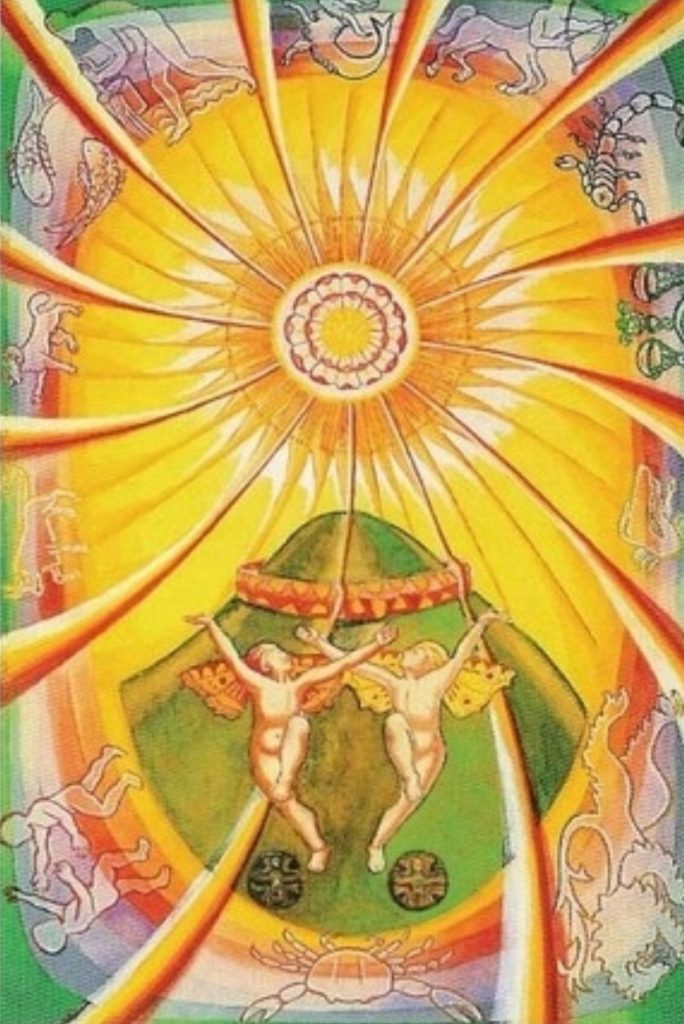
This card represents Heru-ra-ha, the lord of the new Aeon, in his manifestation as the spiritual, moral, and physical Sun. The purpose of the Aeon is the complete emancipation of the human race. The zodiac around the card is a representation of the body of Nuith. The green mound represents the fertile earth and around the mound is a wall – this indicates that the new aeon does not mean the absence of control. Young twins represent the male and female, youth, and innocence and represents the next stage to be attained by mankind. Admittedly we’re still quite early in the current aeon but Crowley believed that ideas of sin and death have been abolished, he states “it must be one of the great advances in adjustment of the new Aeon to work out simply and without prejudice the formidable problems which have been raised by the growth of civilisation.” Looking at the current state of the world we’ve got a long way to go!!! He goes on to say “Largely owing to their own intransigence, those people have been born under a different spiritual law; they find themselves not only persecuted by their ancestors but bewildered by their own uncertainty of foothold. It must be the task of the pioneers of the new Aeon to put this right.”
XX – The Aeon
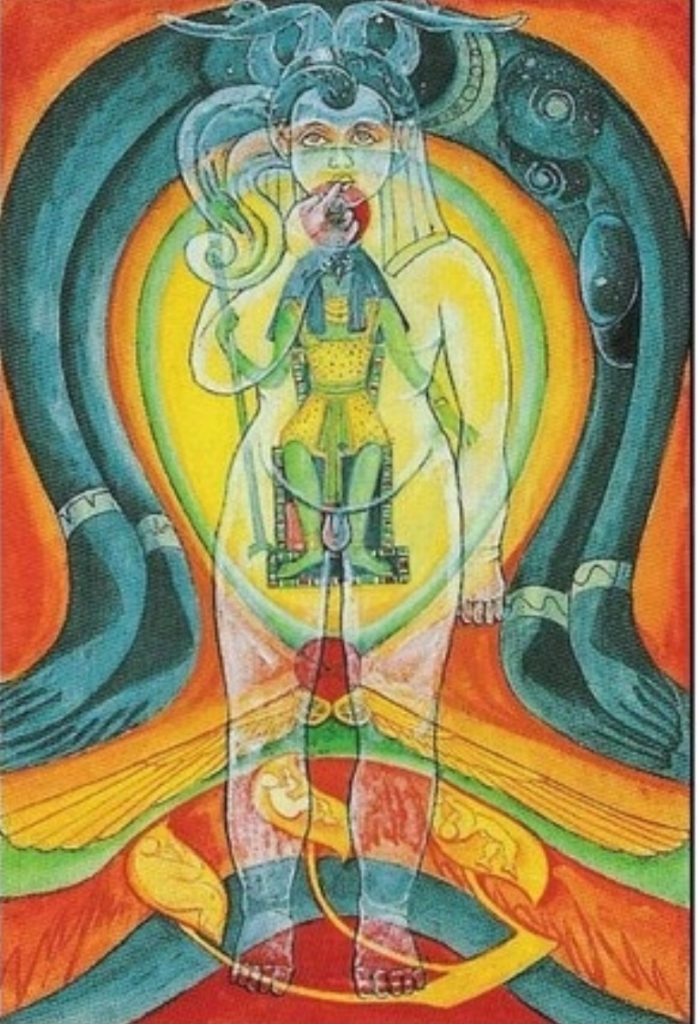
In keeping with his belief that this card deck has been updated for the new Aeon, Crowley has departed completely from the traditional judgement card and replaced it with Aeon. The judgment card heralded judgement day where the dead rose from their graves after being awoken by the horn of Gabriel. Crowley believed that the world was destroyed by Fire in 1904 when Horus took the place of Osiris in the position of the hierophant. Thus, this card shows the angel bringing news of the new Aeon to Earth. The body of Nuith drapes around the top of the card and her mate, Hadit, is shown in the globe of fire representing eternal energy. It is as a result of their marriage that their child Horus is born only now, he is to be known as Heru-ra-ha. This indicates he is a double God, both extroverted and introverted. Crowley suggests that a study should be made of the Book of the Law to further understand this symbolism – it’s on my reading list but for now, I can’t offer any further insight, sorry! He points out that Heru is also Hru, the great angel set over the tarot. There is allusion to the next aeon in the sign of Libra which will be the fall of the Great Equinox. Crowley speculates that from looking at 500 years either side of the start of the previous Aeon that it is likely we are currently in another ‘dark age’ but he believed that today we have brighter torches and more torch bearers.
XXI – The Universe
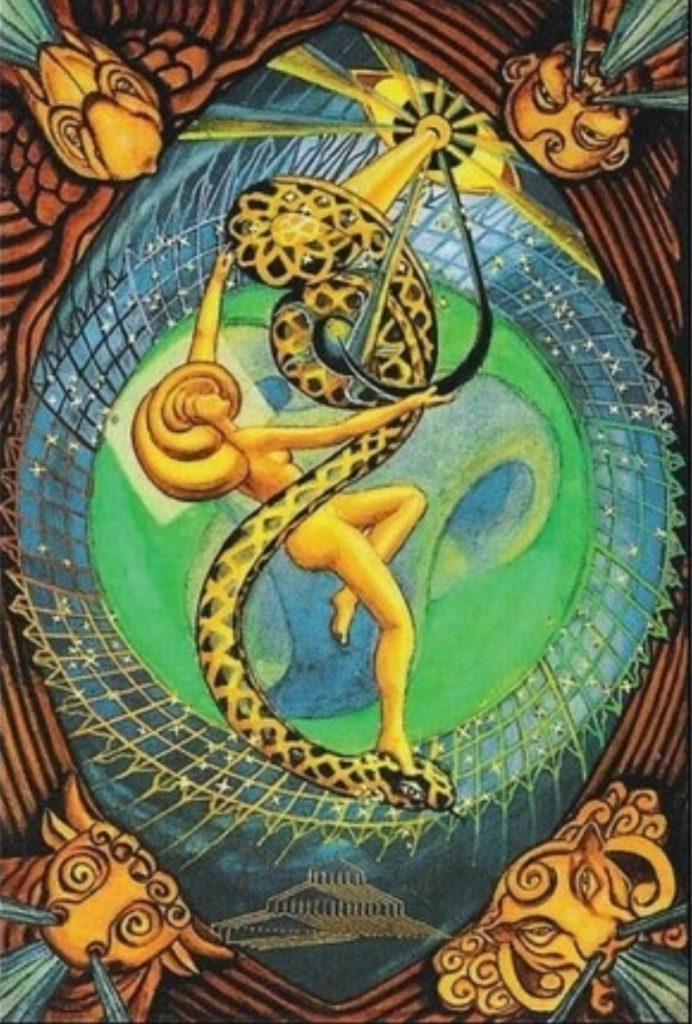
As it comes at the end of the trump cards, or major arcana, the universe is the complement of the fool. It is attributed to the letter Tau, together with aleph it spells the word Ath, which means essence. As in the beginning there was nothing so to at the end must also be nothing, but nothing in it’s complete expansion as previously discussed – see ain soph aur.
The letter Tau is attributed to Saturn, because of its slow progress and dull heavy qualities, the element of earth was associated with this symbol, the three original elements – fire, air, and water were sufficient for primitive thought but earth and spirit represent a higher growth. Crowley links Saturn to Binah and the queens scale of observed nature, as soon as the end of a process is reached, it returns automatically to the beginning. He talks again of the nature of all things to contain within them their opposite, that the sun contains within it blackness.
This card refers again to the ‘setting of the daughter upon the throne of the mother’ and is a completion of the great work exactly as the fool symbolises its beginning. “The fool is the negative issuing into manifestation; the universe is that manifestation, its purpose accomplished ready to return. The 20 cards that lie between these two exhibit the great work and its agents in various stages.” The various symbols on the card represent the chemical elements, the kerubim, the quinaries of the zodiac, the building of the house of matter, the principal bodies of the solar system, all dancing in loops and whorls.
The woman/child depicted in the card is stated by Crowley to be so beautiful and glorious that of all the visions and glories he witnessed “there is not one which is worthy to be compared with her littlest fingernail.” Her name is not to be spoken, thought is smitten dead before her, there are no words to conjure her nor adorations to praise her. Upon the combs in her hair are the names of the seven secret gods, names unknown to the angels, archangels, and the leader of the armies of the lord. He finishes “Holy, holy, holy art thou, and blessed by thy name forever, unto whom the aeons are but the pulsings of thy blood.”
The Court Cards
As I’ve already stated, Crowley assigns each suit and each court card to an element, as such they can be said to represent and elemental part of the element, the queen of wands for example is the watery part of fire, that is the fluidity of fire. In the interests of time I am going to focus on the key attributes of each card and as always I recommend you read the book of thoth for a deeper understanding of Crowley’s interpretations of each card. As each trump card was associated with Hebrew letters, zodiacal signs, planets, elements etc, the lower cards are associated with their equivalent hexagram in the Yi King, or I Ching.
The Knight of Wands
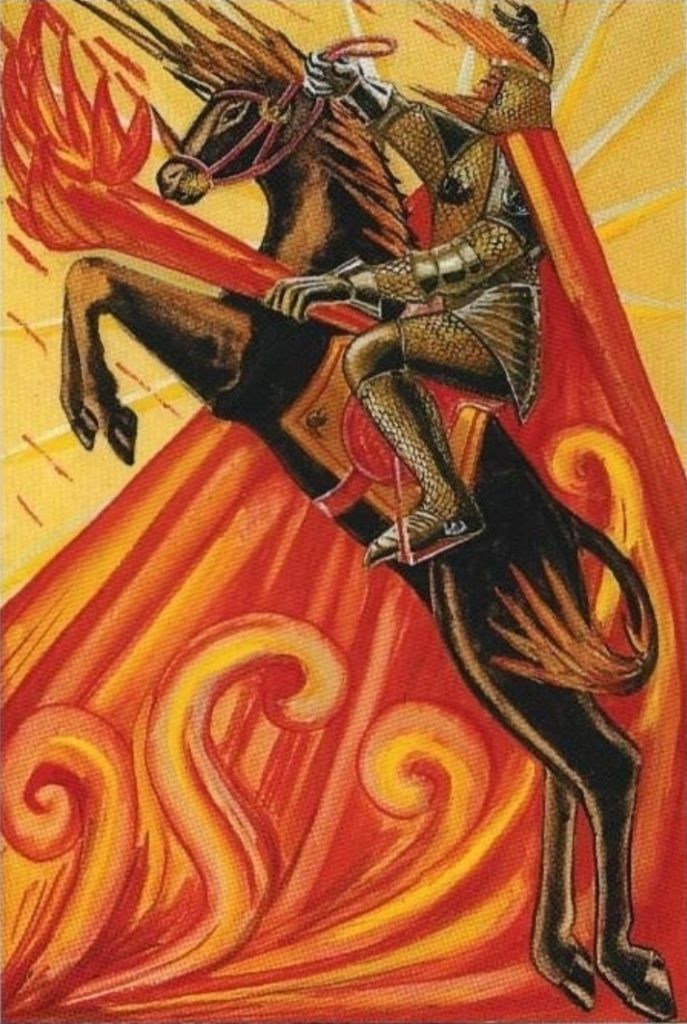
The Knight of Wands represents the fiery part of fire, he is a warrior bearing a flaming torch and riding a leaping black horse. The moral qualities of this figure are activity, generosity, fierceness, impetuosity, pride, impulsiveness and swiftness in unpredictable actions. If wrongly energised, he is evil minded, cruel, bigoted and brutal. If he fails in his first effort, he has no resource. In the I Ching the fiery part of fire is represented by the 51st hexagram, and while the significance is largely in line with the tarot definition, great emphasis is laid on the revolutionary character of the related events. The seeker is advised to keep a cool head and beware of untimely action but go forward with a tense confidence in their own ability.
The Queen of Wands
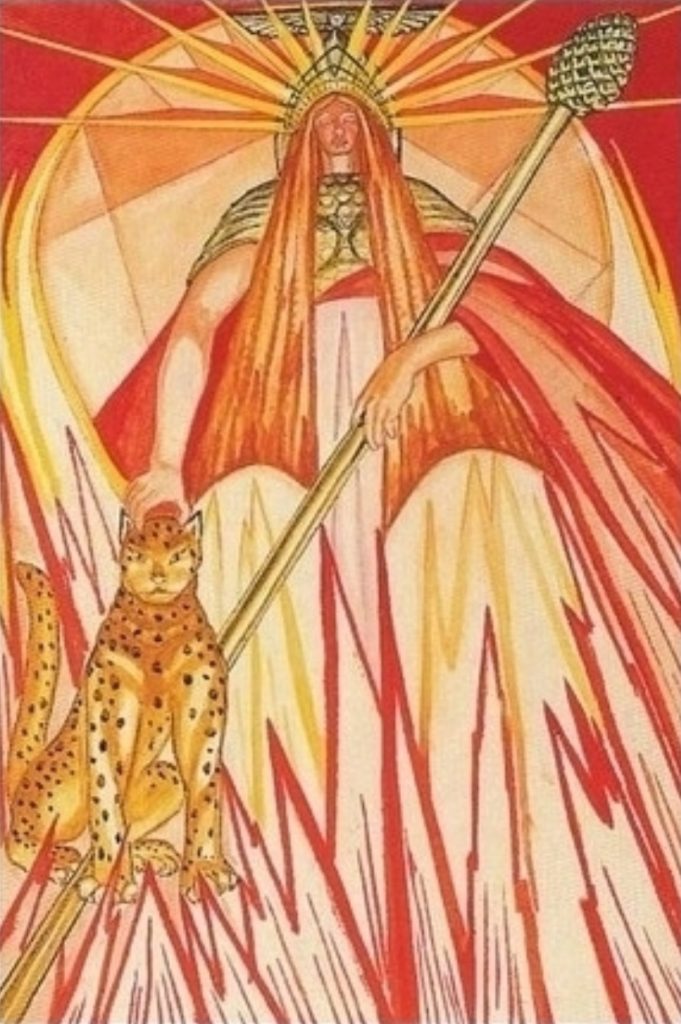
The Queen of Wands represents the watery part of fire. She wears scaled mail and is seated on a throne of flame; the geometrical light shows her material power. The characteristics of the Queen are adaptability, persistent energy, calm authority, kindness, and generosity. There is much pride in this card but as with the knight she lacks spontaneous nobility and could be considered a self-satisfied snob. She may also have the tendency to brood, come to the wrong decision and then react with great savagery. She may be easily deceived and is likely to show herself to be obstinate, even tyrannical. She harbours grudges and may turn on her friends for unfathomable reasons. In the I Ching, the watery part of fire is represented by the 17 hexagram which goes further on her characters that there is capacity for clear ideas and steady work but only when guided by another creative mind. She tends to be melancholy which she tries to mediate with intoxication or furious outbursts.
The Prince of Wands
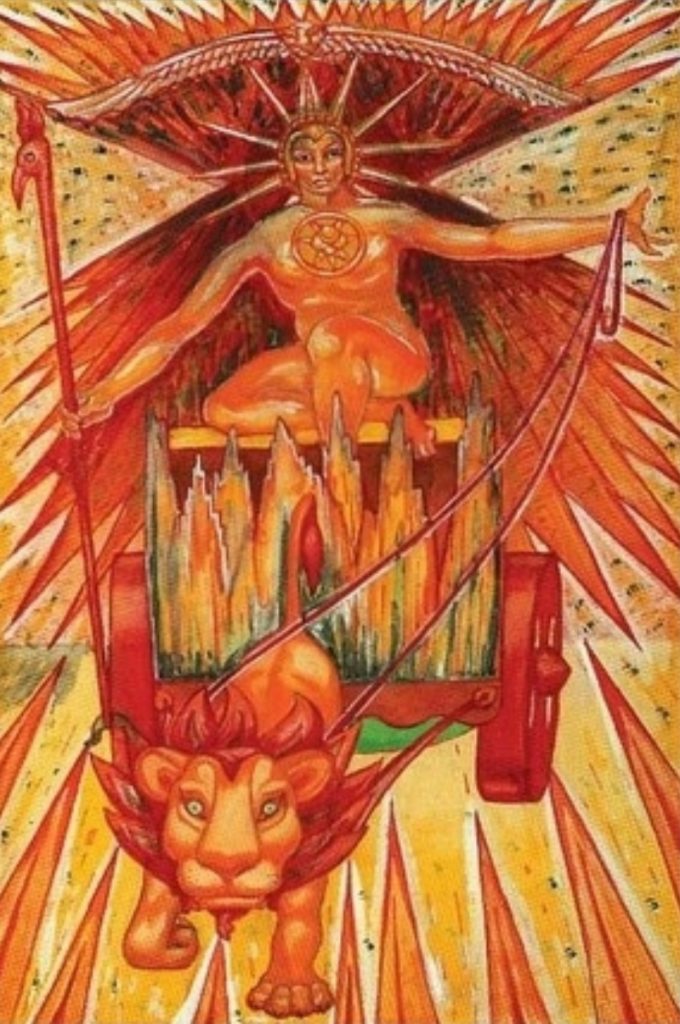
The Prince of Wands represents the airy part of fire with its ability to expand and become increasingly volatile. He is a warrior in scale mail, but his bare arms represent his vigour and activity. His moral qualities are swiftness and strength, but he is inclined to act on impulse; he may be easily led and is often violent, especially in the expression of his opinions. He likes to take the contrary position for the sake of the argument but is slow to make up his mind. He is intensely noble and generous and may be an extravagant boaster. He is romantic to the point of folly and my play elaborate practical jokes, he may pick on someone for years without hostility and would be willing to give this subject the shirt of his back should it be needed – a characteristic of a lot of male friendships. One of his great faults is pride and he holds infinite scorn. His courage is strong and his endurance unending and as such he will always win out in the very long run; he works for the sake of it without any desire for a result. When the worst characteristics of this person are present, they are the antithesis of those already mentions, there is a sadistic cruelty in him, he may be intolerant, prejudiced, and lazy just to avoid trouble. In the I Ching the airy part of fire is represented by the 42nd hexagram which further comments on the character that when full of virtue he contemplates work of tremendous scope for the betterment of mankind but to whom none will contribute while many seek to assail him.
The Princess of Wands
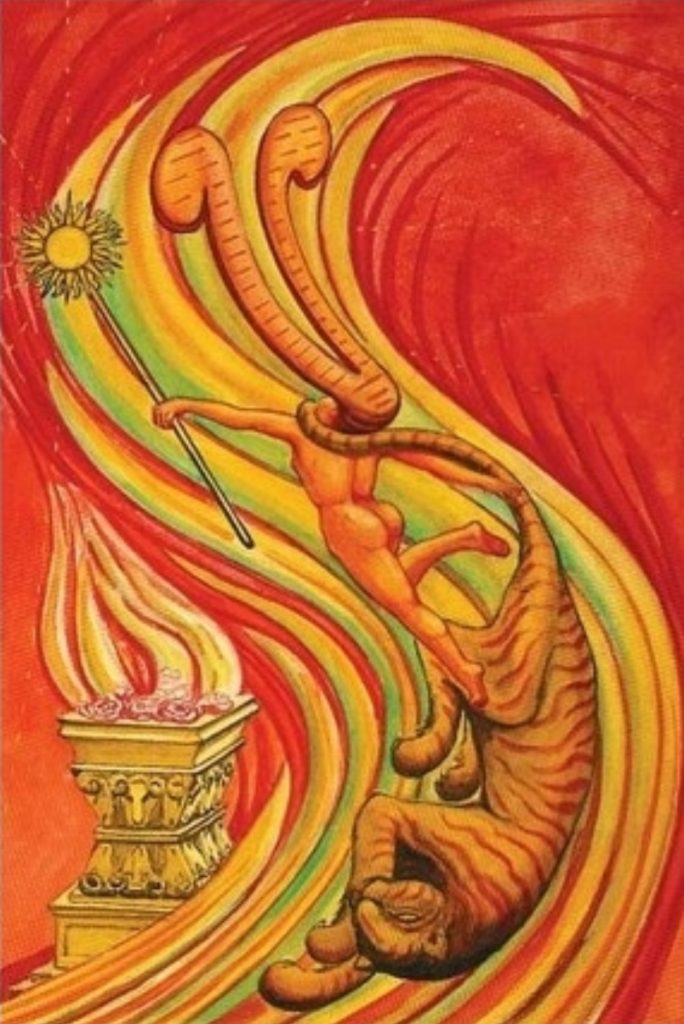
The Princess of Wands represents the earthy part of fire, that is the fuel and implies the irresistible chemical attraction of the combustible substance, as such she appears naked because chemical action can only take place when the element is perfectly free to combine with its partner. The character of the Princess is extremely individual, she is brilliant and daring, her beauty comes from her vigour and energy. In anger or love she is sudden and violent. She consumes all that comes into her sphere. She is ambitious and impatient. When her worst characteristics are shown she becomes superficial and theatrical – a bit of a drama queen – but with no self-awareness, she believes entirely in herself, she is cruel, unreliable, and domineering. In the I Ching the earthy part of fire is described by the 27th hexagram, it shows someone with great passion and recklessness, they are insatiable.
The Knight of Cups
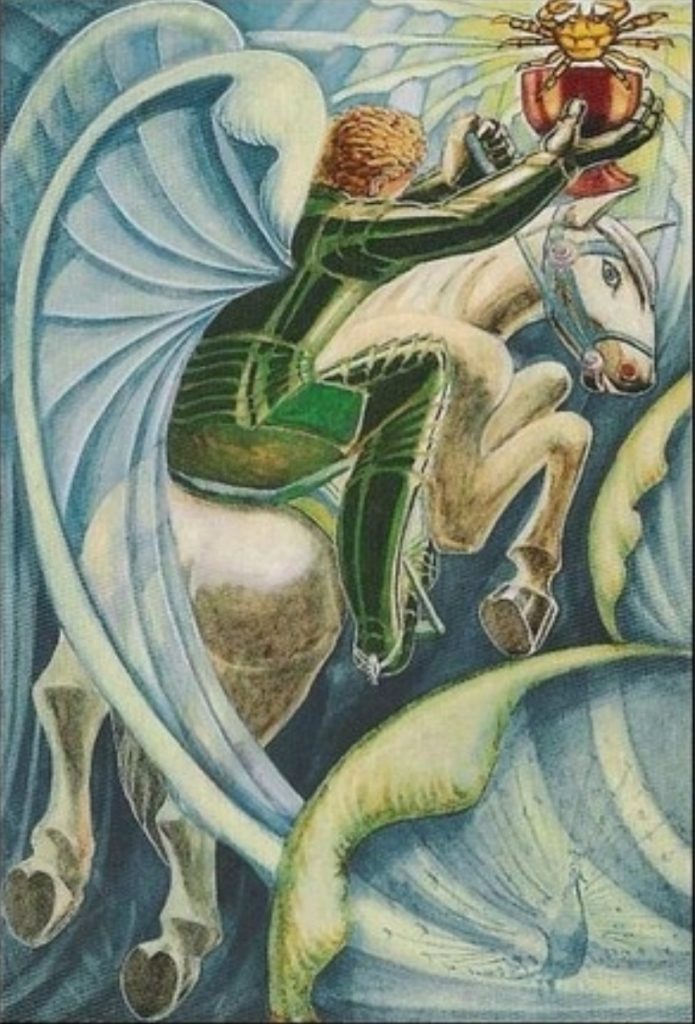
The Knight of Cups represents the fiery part of water, the swift attack of a torrential downpour and water’s ability to dissolve. He is clothed in black armour. The characteristics of the person signified by this card are mostly passive, he is graceful and has many interests but little depth of knowledge, he is passively amiable and exceedingly sensitive to external influences. His worse characteristics are laziness and lies but he possesses an innocence and purity, he is thoroughly superficial. In the I Ching the fiery part of water is represented by the 54th hexagram, which deals with the difficulty in finding a mate, his tendency to mismanage his affairs and unless he is extremely lucky a life of failure and disaster often ending in mental health problems. The use of drugs is catastrophic for this person.
The Queen of Cups
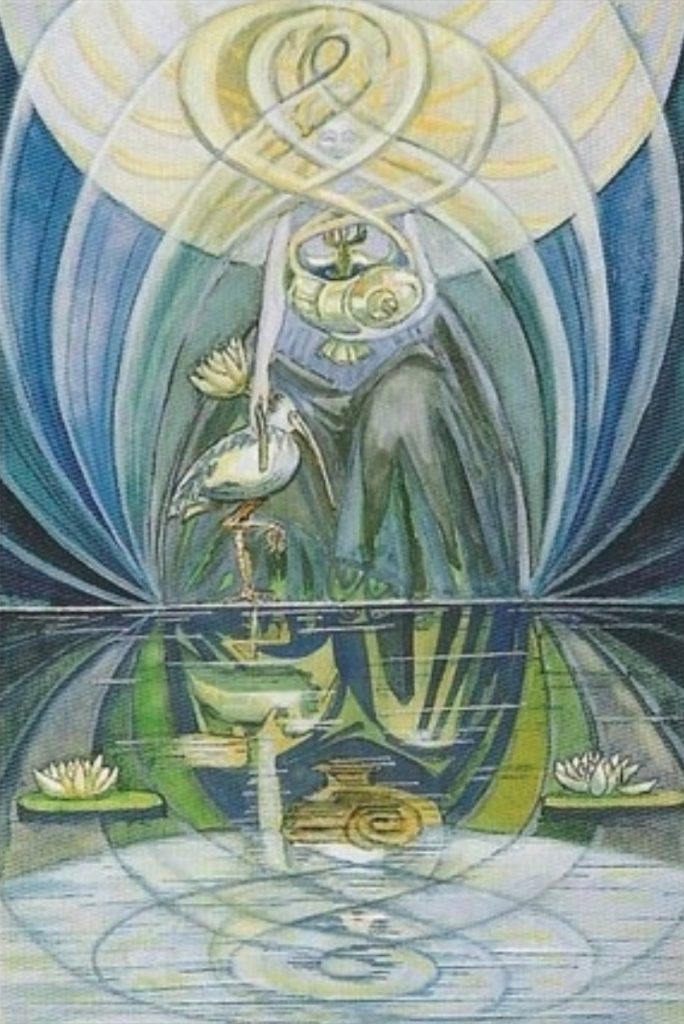
The queen of Cups represents the watery part of water, it’s powers of reception and reflection. Her image is of purity and beauty, but it is almost impossible to see the truth of her as she reflects the nature of the observer almost perfectly. At her best she represents dreaminess, illusion, and tranquillity, she is able to receive and transmit without being affected. At her worst everything that passes through her is distorted and refracted. The I Ching represents the watery part of water with the 58th hexagram and consists of vague pleasures, that people of this type have no character of their own but are reflections of those around them, as such they are often exceedingly popular and are inclined to attract and lead people.
The Prince of Cups
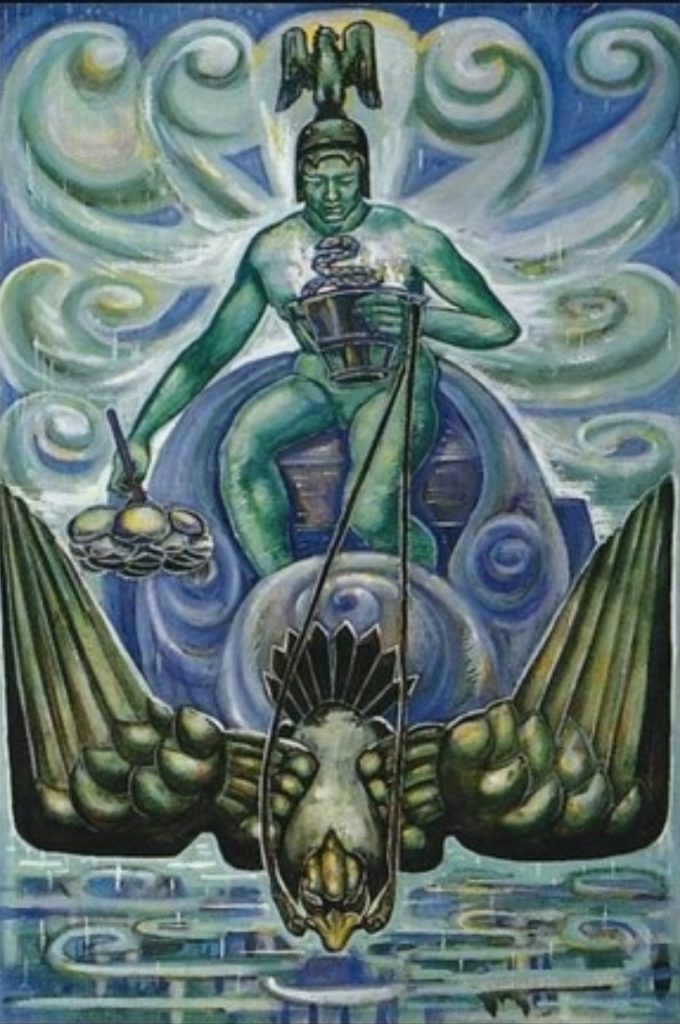
The Prince of Cups represents the airy part of water, on one hand elastic, volatile with the hydrostatic equilibrium and on the other a catalyst and the energy of steam. His armour seems more like a growth than a covering and his wings are almost gaseous in reference to volatile power. The moral characteristics of this person and subtlety, secret violence and craft. He is an artist and intensly secretive, superficially he seems calm and unflappable but this is a mask for the most intense passion. He seems receptive to outside influence but he accepts them only to use them for his own advantage. He is without conscience and is often distrusted by people who feel they do no and can not understand him. He is ruthless and cares intensely for power, knowledge and his own aims while feeling no responsibility to others. In the I Ching the airy part of water is represented by the 61st hexagram, one of the most important for it “moves even pigs and fish, and leads to great good fortune.”
The Princess of Cups
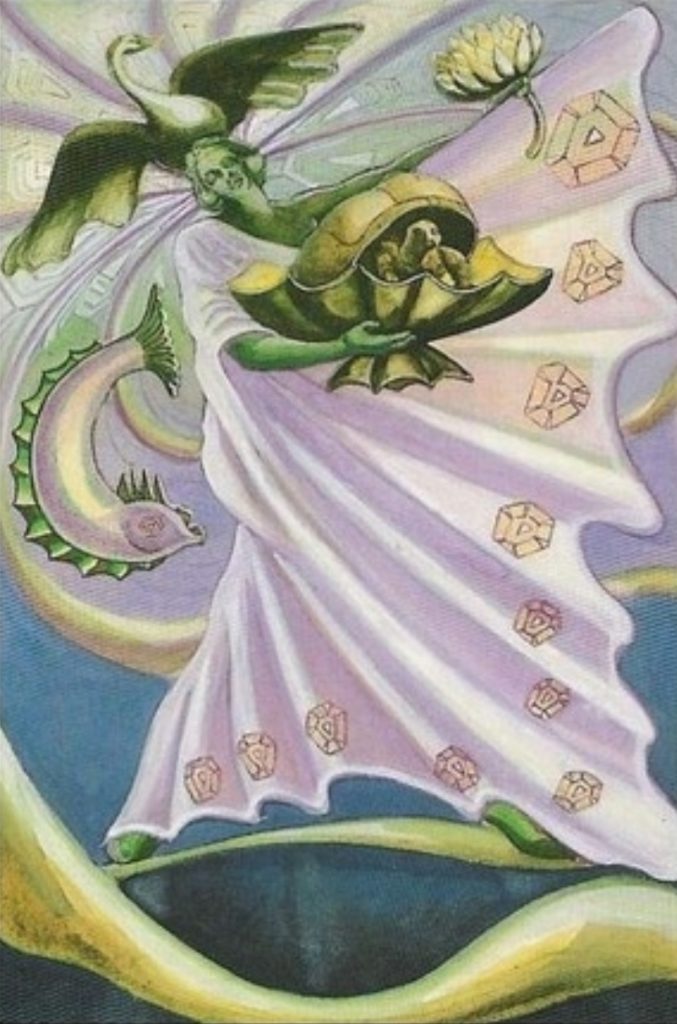
The Princess of Cups represents the earthy part of water, the power of water to support life and form the basis of chemical combination. She is shown as a dancing figure and represents the entire process of creation. The character of the Princess is grace, sweetness, kindness, tenderness. She lives in a world of romance; she might wrongly be considered selfish and lazy but she quietly and effortlessly goes about her work. In the I Ching the earthy part of water is represented by the 41st hexagram, which means the dissolution of all solidity. People described by this card are very dependent on others but reciprocate by helping.
The Knight of Swords
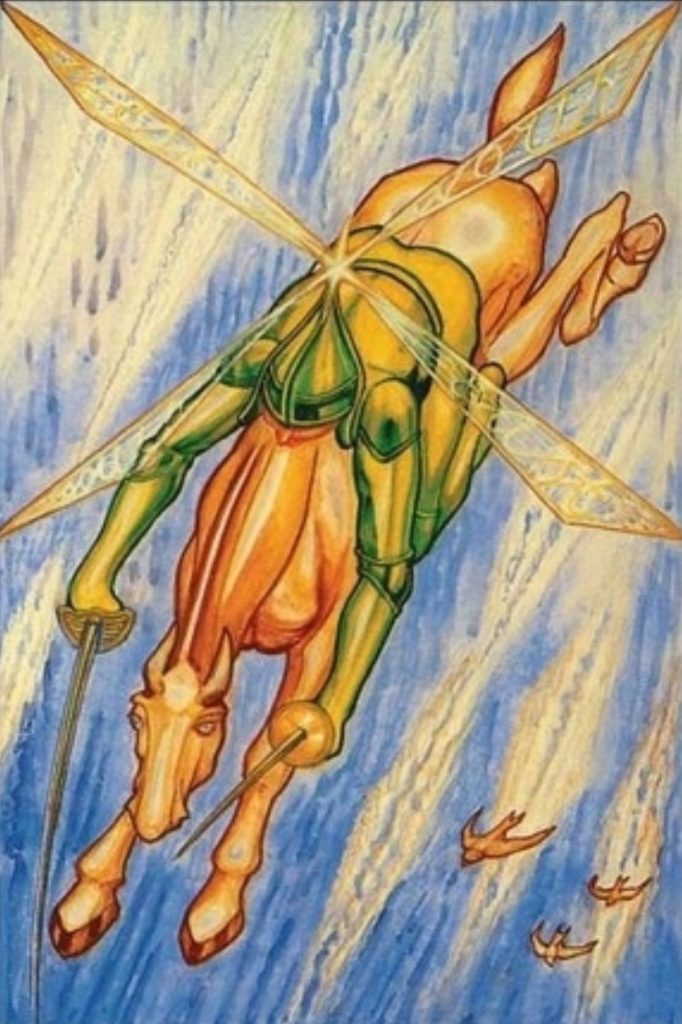
The Knight of Swords represents the fiery part of air, the wind and the storm. He is a warrior riding a maddened steed, he represents the idea of attack. The moral qualities of a person are activity and skill, subtlety and cleverness. He is fierce, delicate and courageous but prey to his ideas which are inspired but without reflection. At worst these qualities are absent, he is incapable of decision and lacks purpose, any action he takes is easily opposed and dismissed. In the I Ching the fiery part of air is represented by the 32nd hexagram which largely aligns with the description given adding perseverance in well doing or continuously acting out the law of one’s being.
The Queen of Swords
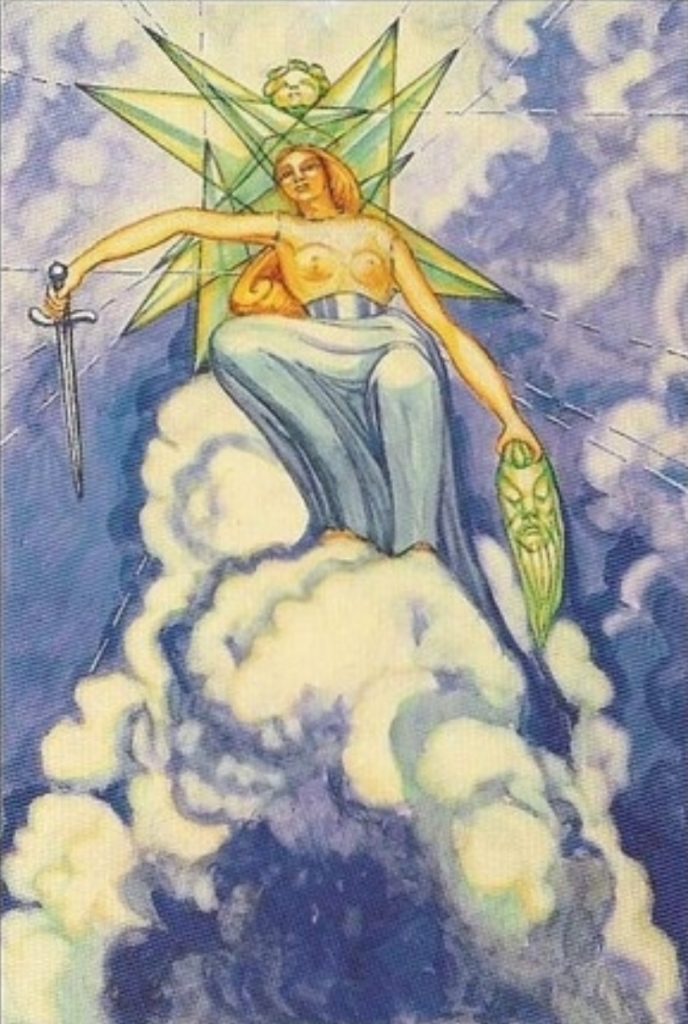
The Queen of Swords represents the watery part of air, it’s power of transmission. She is clothed only in a sarong and carries a sword and the severed head of a bearded man. She is the liberator of the mind. The person symbolised in this card is a keen observer and is very perceptive, she is an individualist, in action she is confident, gracious, and just and her ability in dancing and balance are exceptional. At worst these qualities are turned to unworthy purposes, she is cruel, sly and unreliable, her beauty makes her very dangerous. In the I Ching the watery part of air is represented in the 28th hexagram, a character excellent in itself but which cannot support interference, care and preparation are a safeguard. Help is best sought from apparently unsuitable comrades as their alien strength provides support where the character is weakest. Foolish and rash adventures incur no blame if the feeling is that the right course was taken. People represented by this queen acquire intense love and devotion from the most unexpected quarters.
The Prince of Swords
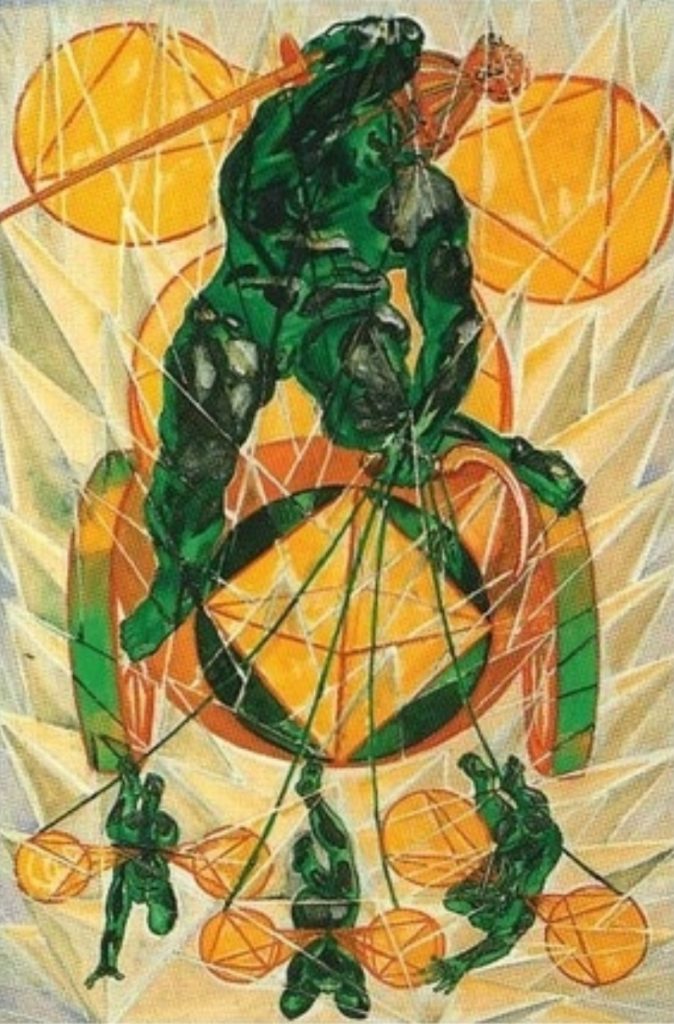
The Prince of Swords represents the airy part of air, it is intellectual. He is clothed in closely woven armour while his chariot is drawn by capricious children. Any progress made is accidental. This is a perfect picture of the mind. The person symbolised here is purely intellectual, full of ideas and designes, a mass of fine ideals unrelated to practical effort. He is clever and rational but unstable in purpose. He is indifferent to even his own ideas knowing them all to be as good as each other. In the I Ching the airy part of air is represented by the 57th hexagram and means both flexibility and penetration. These people are of value only when firmly mastered by a creative will fortified by an intelligence superior to their own, though this happens only rarely. They often wander from one vice or cult to another supporting with full conviction for a whimsical moment. It is easy to be deceived by such people, Crowley likens them to imbeciles offering you the works of Plato but in this way they may acquire a reputation for both depth and breadth of mind.
The Princess of Swords
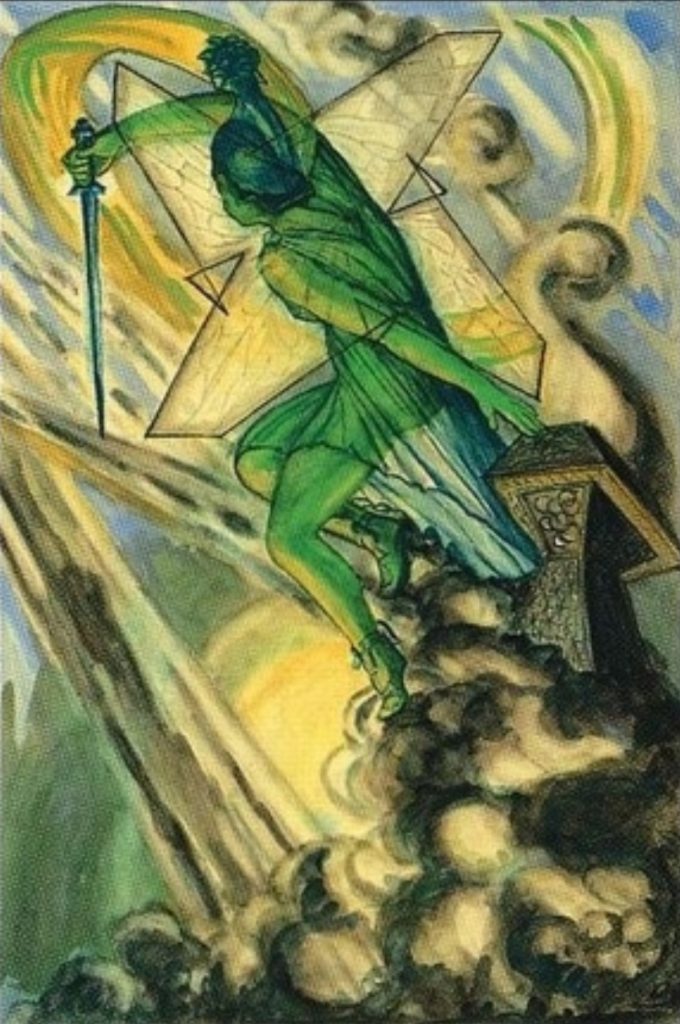
The Princess of Swords represents the earthy part of air, the fixation of the volatile. She represents the influence of heaven on earth. There is a suggestion of the Valkyrie and to a degree she represents the anger of the Gods. The character of the person represented is stern and revengeful, her logic is destructive, she has great practical wisdom and shows great cleverness and management of practical affairs, especially if they are controversial. At worst she is incoherent, of low cunning. In the I Ching the earthy part of air is represented in the 8th hexagram which means troubles and is the most unhappy symbol. The fine qualities of air are weighed down, the people characterised are prey to constant anxiety and are crushed by responsibility, especially in family affairs. She has the capability to overturn the table. Such people are exceedingly rare but when they take the right path they will eventually receive their reward.
The Knight of Discs
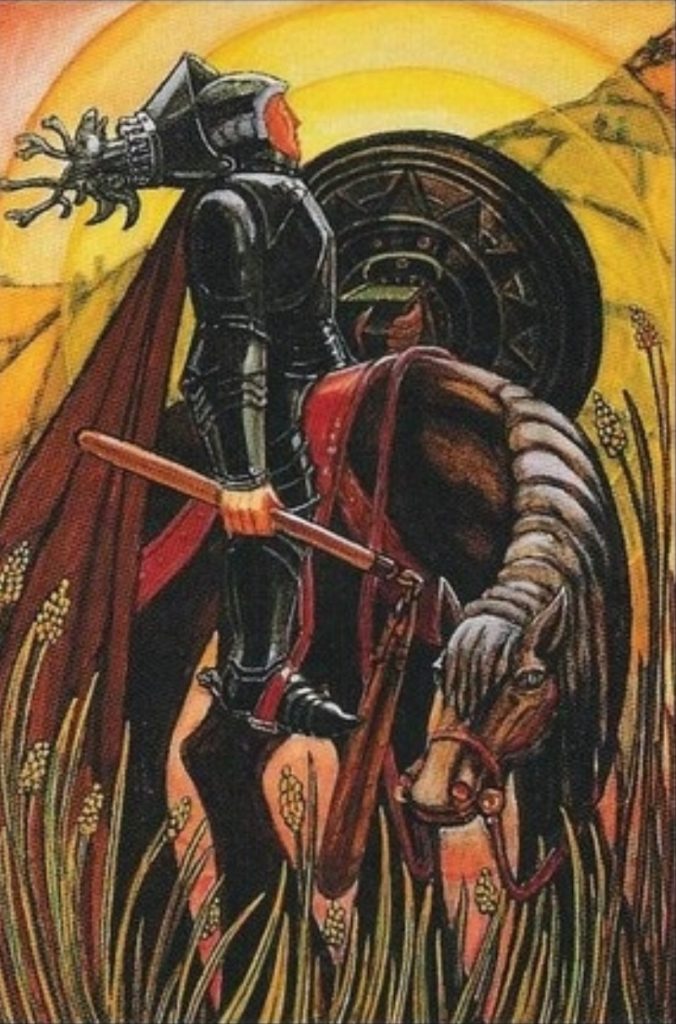
The Knight of Discs represents the fiery part of earth, volcanoes, earthquakes, and earth as the producer of life. Those who are represented by this card are dull and preoccupied with material things, they are patient but have little intellectual grasp of even the matters that concern them most closely. Their success is due to instinct and imitation, they lack initiative. At worst they are hopelessly stupid and incapable of foresight or of taking an interest in anything outside of them. They are churlish, jealous and surly but have not the intelligence or courage to better themselves, yet they are always meddling in petty affairs and inevitably spoil whatever comes their way. In the I Ching the fiery part of earth is represented by the 62nd hexagram. The character described has an ambition but a tendency to waste time day dreaming. He is a farmer by nature and when he turns his attention and ambition thus, he can begin to thrive.
The Queen of Discs
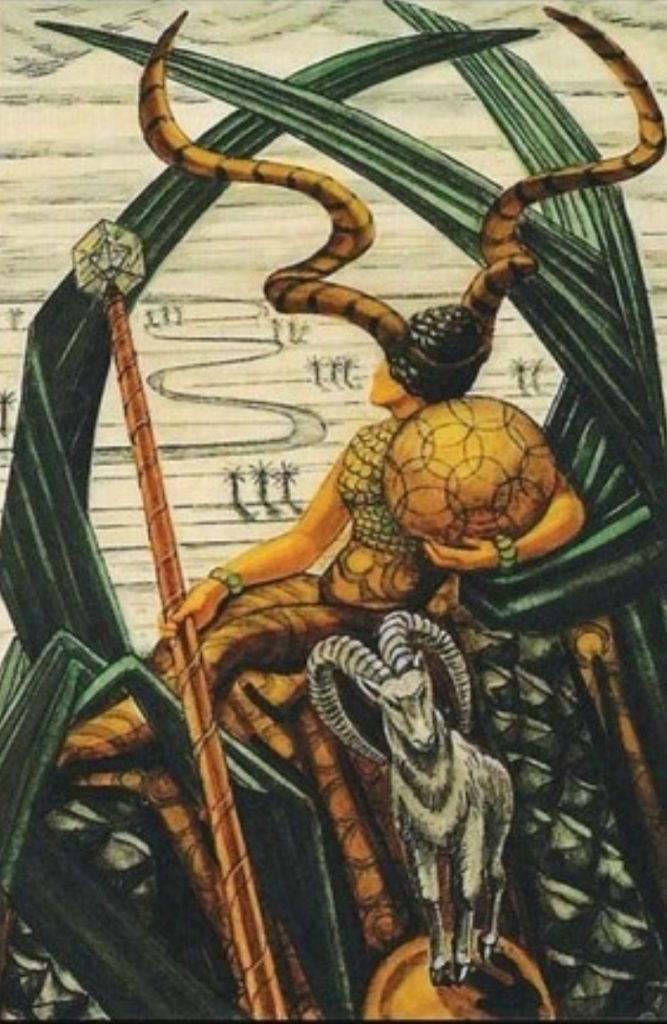
The Queen of Discs represents the watery part of earth, that function of the element that is the mother. She is throned on vegetation and her symbols represent the ambition to take part in the great work of creation. Persons signified by this card possess the finest of the quiet qualities, they are ambitious but in useful ways, they possess a wealth of affection, kindness, and heart. They are not particularly intelligent but instinct and intuition are more than adequate for their needs. They are quiet hard-working people, practical, sensible, and sexual. They tend to the use of alcohol and drugs to getting outside of themselves. At worst they are dull, servile, and foolish and cannot even seek to rise above their lot in life. In the I Ching the watery part of earth is represented by the 31st hexagram which means influence and the general advice is to go forward quietly without overt attack on existing situations.
The Prince of Discs
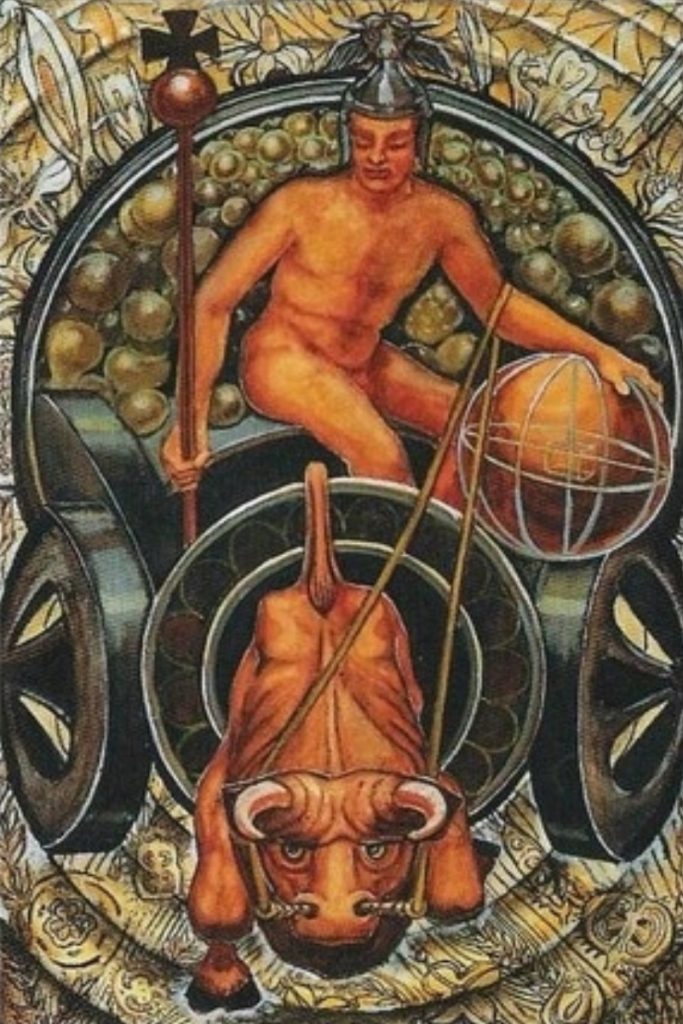
The Prince of Discs represents the airy part of earth, its florescence and fruit. The character denoted by this card is that of great energy in the most solid and practical of matters. He is energetic and enduring, a strong manager and worker. He is competent, thoughtful, and cautious, he adapts things and circumstances to his purposes in a slow, well thought out plan. He is lacking in emotion and may appear insensitive; he appears this way because he makes no effort to understand ideas which are beyond his scope. He is slow to anger but if driven becomes apoplectic. At worst these characteristics are degraded. In the I Ching the airy part of earth is represented by the 53rd hexagram and symbolises the slow emancipation from repressive conditions.
The Princess of Discs
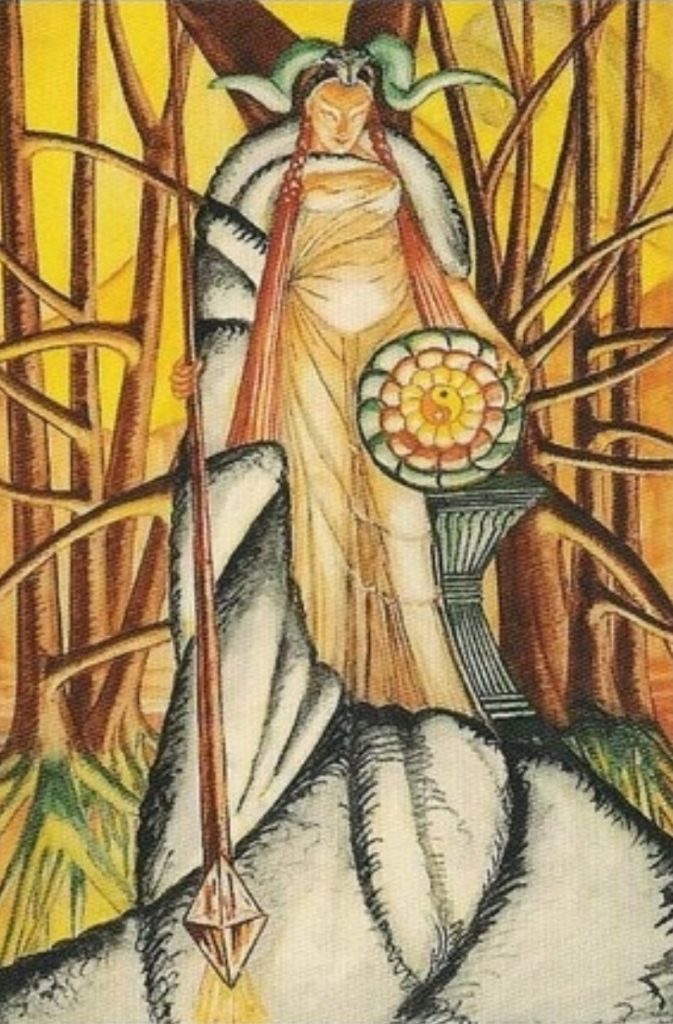
The Princess of Discs is the last of the court cards and represents the earthy part of earth. The characteristics of the individual signified by this card can be summarised by saying she is womanhood in its ultimate projection, she contains all the characteristics of woman and the manifestation of these characteristics is entirely dependent on the influences she has been subjected to. In every case her attributes will be pure. She may have a reputation for being inconsistent and contrary but that is the nature of her characteristics, each aspect of her stands alone, uninfluenced by the others. In the I Ching the earthy part of earth is represented by the 52nd hexagram and means a mountain.
The small cards
As you will see, Crowley names each of the small cards in a similar manner to the Grand Etteilla but they are named very differently, there is a table showing each of the names available for download on my website. Another note is that in the Book of Thoth, Crowley interchanges the terms discs and pentacles, I have used his terms as they occur in his book rather than changing to one consistent term.
The Aces




The Aces represent the roots of the four elements, they are above and distinct from the other lower cards. There is no manifestation of the elements in their material form in these cards but they form a link between the small cards and the princesses who rule the heavens thus, the ace of wands relates to asia, the ace of cups to the pacific ocean, the swords to the Americas and the ace of discs to Europe and Africa.
The Twos




In the twos chokmah, or wisdom is uncontaminated by any influence and therefore the elements appear in their original harmonious condition. The two of wands represents the lord of dominion and the energy of fire in its highest form. The two of cups is the lord of love and acts in a similar way to water. The two of swords is the lord of peace, Crowley directs the student to study his essay on silence for a greater understanding of the negative form of a positive idea. The two of pentacles (or discs) is the lord of change but it is that of endless change, without beginning or end.
The Two of Cups is named Love
The Two of Discs is named Change
The Two of Swords is named Peace
The Two of Wands is named Dominion
The Threes




The threes are referred to binah, and each is the symbolism of understanding, an idea has become fertilised, the triangle formed. In each case there is stability which endures and from which something, perhaps a child can come. The three of wands is the lord of virtue, the idea of will and dominion as interpreted in character. The three of cups is the lord of abundance, love come to fruition. The three of swords introduces the idea of division and mutability, the universal sorrow and the quality of melancholy. The three of pentacles is the result of the idea of earth and is the lord of work indicating something has definitely been done.
The Three of Cups is named Abundance
The Three of discs is named Power
The Three of Swords is named Sorrow
The Three of Wands is anmed Virtue
The Fours




These cards are attributed to Chesed, kindness or love between people. The connection between the number four and three is very complex, an important characteristic is that four is below the abyss and as such means solidification and materialisation.
The four of wands is called completion, the manifestation promised by binah has now taken place.
The four of cups is called luxury, the masculine nature of fire makes this appear very positive and clear cut but the element of water threatens its purity and thus is a little unstable.
The four of swords is called truce, it implies peace being maintained through force.
The four of discs is called power, the power that stabilises and dominates. It is law with no aggressive element.
The Fives




In the Naples arrangement, the introduction of the number five shows the idea of motion, this is a revolutionary concept because it upsets the stabilised system, now we have storm and stress.
The five of wands is called strife.
The five of cups is called disappointment.
The five of swords is defeat – there was insufficient power in the four of swords and how a quarrel has broken out.
The five of discs has the soft quiet of the four overthrown and is called worry, in the sense that dogs worry sheep and there is no single action that can affect this issue.
The Sixes




These cards are attributed to Tiphareth, it implies spirituality, balance, beauty, compassion and miracles. It represents consciousness in its most harmonised and balanced form.
The six of wands is called victory which was sudden and violent. The violent nature of this victory destabilises all further wands and leads to undesirable developments.
The six of cups is called pleasure, it represents fertility and scorpio.
The six of swords is called science and is ruled by mercury, in it success turns away from the idea of division and quarrel.
The six of discs is called success and is ruled by the moon, it relates to a balanced system but Crowley cautions that all success is only temporary.
The Sevens




These cards are attributed to Netzach which means eternity or endurance. It relates to Venus and Earth and each of the sevens relates to the degradation of the element, its greatest weakness exposed in every case.
The seven of wands is called valour, energy is at its last gasp, and it struggles desperately, defeat is likely.
The seven of cups is called debauch, its mode is poison, and its goal is madness, it is sinking into the mire of false pleasure, it is almost suicidal.
The seven of swords is called futility, it is a weaker card than the seven of wands and is passive, while the seven of wands was making a final attempt to fight, the seven of swords is incapable and nothing short of a miracle can bring any endeavour to fruition.
The seven of discs is called failure, it is extreme passivity, there is no effort or fight in this card, all work is abandoned, and everything is sunk in sloth.
The Eights




The eights are attributed to Hod which means majesty and glory. The eights come in a sense as a remedy to the sevens, the mischief has been done and now there is a reaction against it.
The eight of wands is called swiftness and is attributed to mercury and Sagittarius.
The eight of wands separates fire from combustion and destruction and represents its energy.
The eight of cups is called indolence, it is the apex of unpleasantness and is ruled by Saturn. It could almost be the morning after the night before but only if the party on the night before had some key aspect that failed to go to plan.
The eight of swords is called interference, it is the error of being good natured when being such is disastrous, if one must fight a knockout blow is required. There is also unforeseen bad luck in this card, some small mishap with huge consequences. The eight of discs is called prudence, it implies that financially the best thing to do is nothing at all, or to put something away for a rainy day.
The Nines




These cards are attributed to Yesod, which is the vessel for movement from one thing to another. Each of these cards gives the full impact of the elemental force in the most material sense.
The nine of wands is called strength and is ruled by the moon and yesod and at its most basic implies the stability given by change.
The nine of cups is called happiness and is ruled by Jupiter and fortune it implies satisfaction but reminds us that the only way to guarantee stability is through change.
The nine of swords is called cruelty, it is ruled by mars and is agony of the mind.
The nine of discs is called gain and is ruled by Venus, it is self-satisfied.
The Tens




These cards are attributed to Malkuth which means kingdom. Here is the end of all energy, there are no planetary attributions, the tens serve as a warning to see where the first wrong step will lead.
The ten of wands is called oppression and is what happens when one uses force and nothing but force all the time. The wand has conquered and done it’s work too well, not knowing when to stop its government has become a tyranny.
The ten of cups is called satiety, the pursuit of pleasure has been crowned with perfect success and constantly it is discovered that having got everything one wanted, one did not want it after all and now one must pay.
The ten of swords is called ruin. It teaches that if one fights for long enough, all ends in destruction. It is not without hope as ruin can never be complete when the governments have smashed each other there will still be the peasant.
The ten of discs is called wealth, here again is the recurring doctrine that as soon as one gets to the bottom one finds oneself at the top. When wealth accumulates beyond a certain point it becomes inert unless intelligence is used to determine its best use. This card is to the small cards what the universe is to the trumps.
